Heat Exchanger Performance: Experiment, Data, Calculations, and Results
VerifiedAdded on 2023/06/03
|17
|3672
|50
AI Summary
This lab report discusses the experiment, data, calculations, and results of heat exchanger performance. It includes the procedure, experimental data, calculations, and results for four different types of heat exchangers. The report also provides tables and figures for better understanding.
Contribute Materials
Your contribution can guide someone’s learning journey. Share your
documents today.
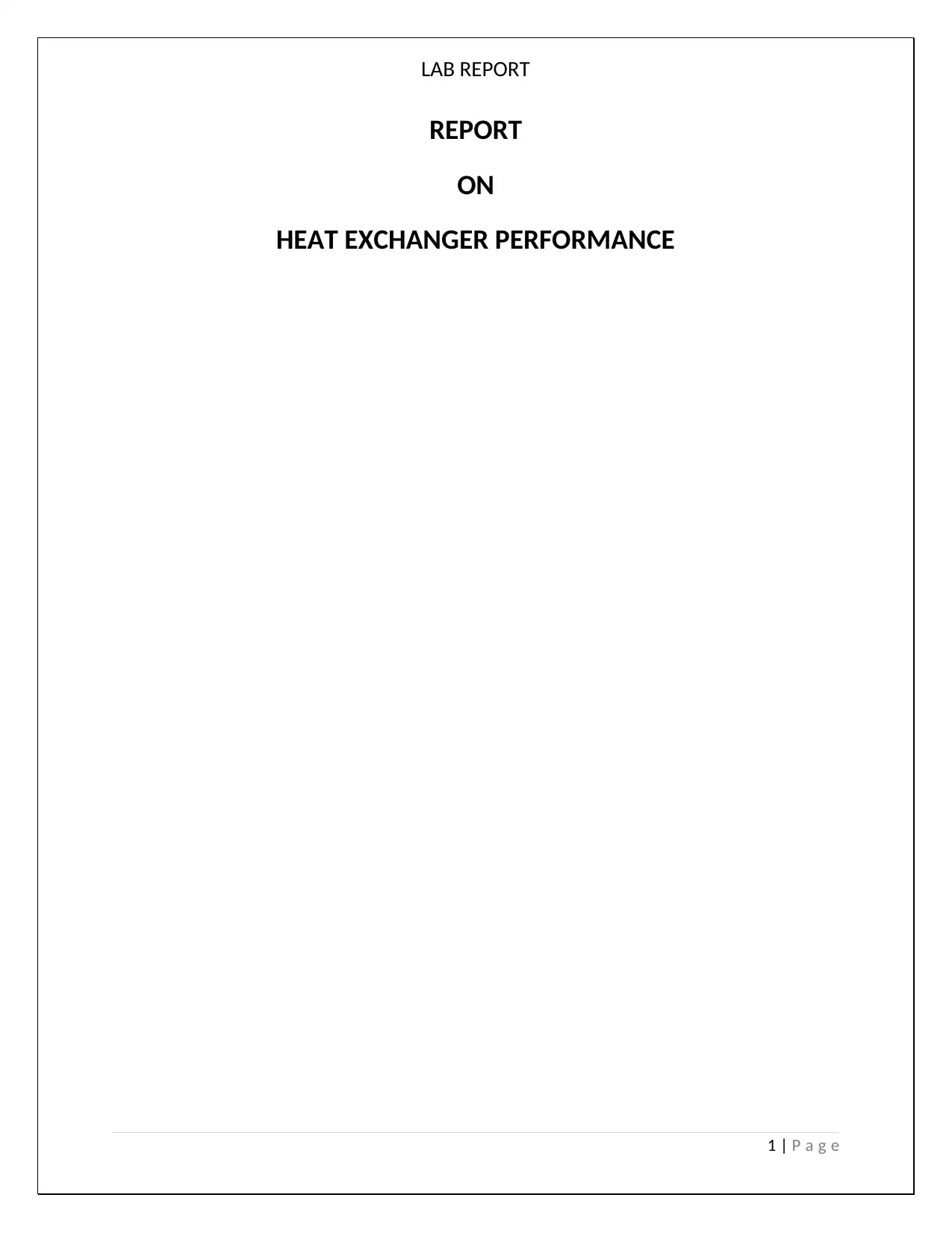
LAB REPORT
REPORT
ON
HEAT EXCHANGER PERFORMANCE
1 | P a g e
REPORT
ON
HEAT EXCHANGER PERFORMANCE
1 | P a g e
Secure Best Marks with AI Grader
Need help grading? Try our AI Grader for instant feedback on your assignments.
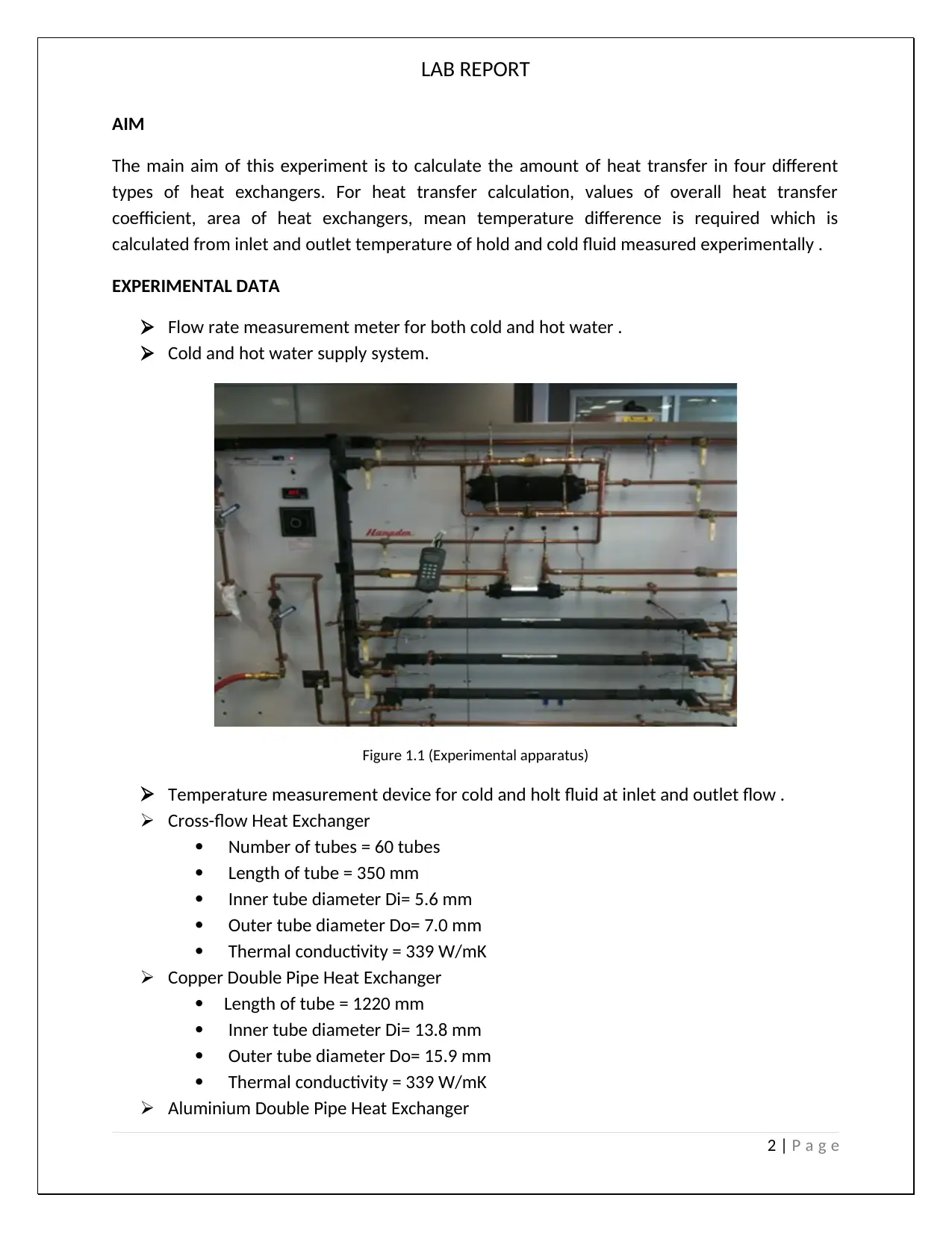
LAB REPORT
AIM
The main aim of this experiment is to calculate the amount of heat transfer in four different
types of heat exchangers. For heat transfer calculation, values of overall heat transfer
coefficient, area of heat exchangers, mean temperature difference is required which is
calculated from inlet and outlet temperature of hold and cold fluid measured experimentally .
EXPERIMENTAL DATA
Flow rate measurement meter for both cold and hot water .
Cold and hot water supply system.
Figure 1.1 (Experimental apparatus)
Temperature measurement device for cold and holt fluid at inlet and outlet flow .
Cross-flow Heat Exchanger
Number of tubes = 60 tubes
Length of tube = 350 mm
Inner tube diameter Di= 5.6 mm
Outer tube diameter Do= 7.0 mm
Thermal conductivity = 339 W/mK
Copper Double Pipe Heat Exchanger
Length of tube = 1220 mm
Inner tube diameter Di= 13.8 mm
Outer tube diameter Do= 15.9 mm
Thermal conductivity = 339 W/mK
Aluminium Double Pipe Heat Exchanger
2 | P a g e
AIM
The main aim of this experiment is to calculate the amount of heat transfer in four different
types of heat exchangers. For heat transfer calculation, values of overall heat transfer
coefficient, area of heat exchangers, mean temperature difference is required which is
calculated from inlet and outlet temperature of hold and cold fluid measured experimentally .
EXPERIMENTAL DATA
Flow rate measurement meter for both cold and hot water .
Cold and hot water supply system.
Figure 1.1 (Experimental apparatus)
Temperature measurement device for cold and holt fluid at inlet and outlet flow .
Cross-flow Heat Exchanger
Number of tubes = 60 tubes
Length of tube = 350 mm
Inner tube diameter Di= 5.6 mm
Outer tube diameter Do= 7.0 mm
Thermal conductivity = 339 W/mK
Copper Double Pipe Heat Exchanger
Length of tube = 1220 mm
Inner tube diameter Di= 13.8 mm
Outer tube diameter Do= 15.9 mm
Thermal conductivity = 339 W/mK
Aluminium Double Pipe Heat Exchanger
2 | P a g e
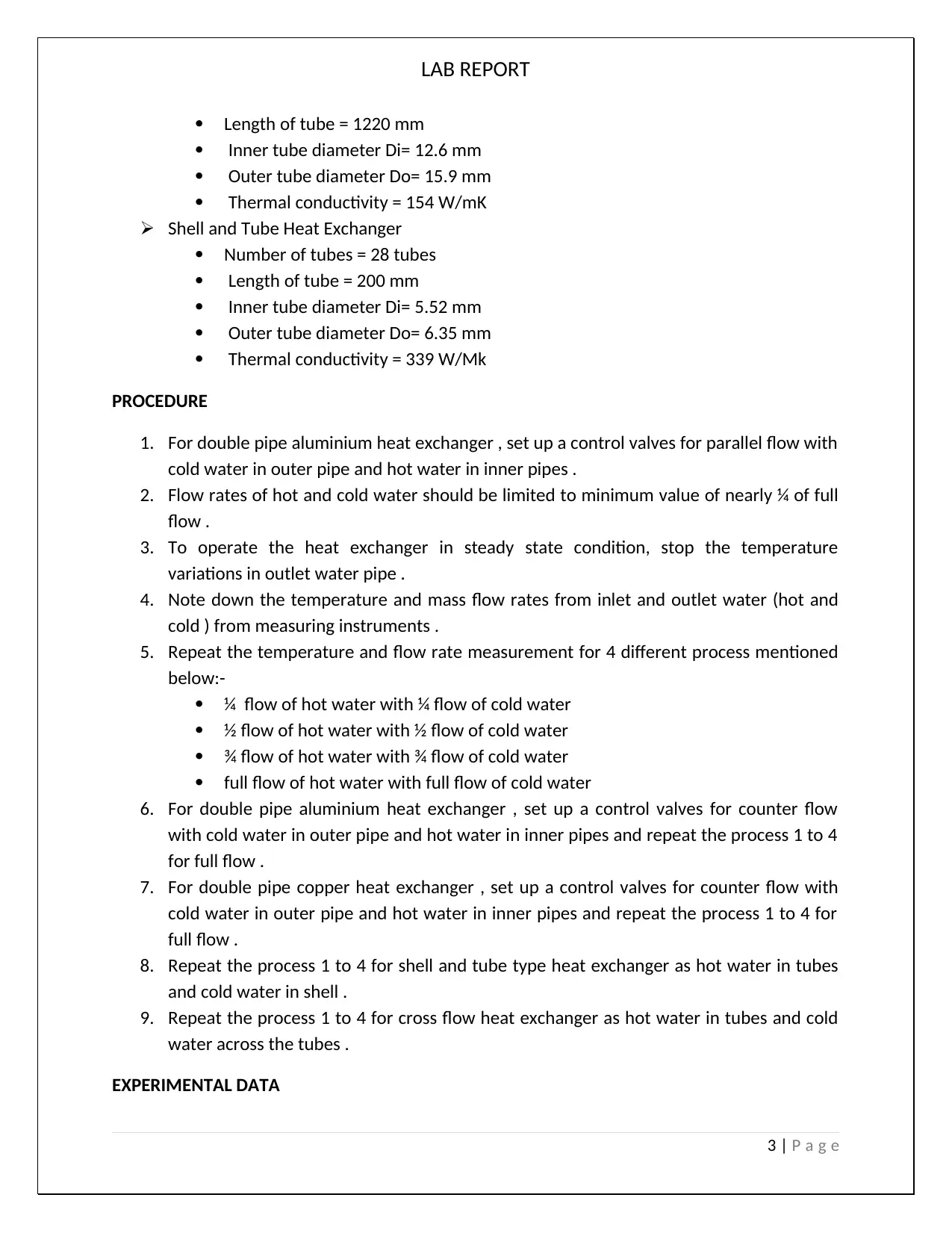
LAB REPORT
Length of tube = 1220 mm
Inner tube diameter Di= 12.6 mm
Outer tube diameter Do= 15.9 mm
Thermal conductivity = 154 W/mK
Shell and Tube Heat Exchanger
Number of tubes = 28 tubes
Length of tube = 200 mm
Inner tube diameter Di= 5.52 mm
Outer tube diameter Do= 6.35 mm
Thermal conductivity = 339 W/Mk
PROCEDURE
1. For double pipe aluminium heat exchanger , set up a control valves for parallel flow with
cold water in outer pipe and hot water in inner pipes .
2. Flow rates of hot and cold water should be limited to minimum value of nearly ¼ of full
flow .
3. To operate the heat exchanger in steady state condition, stop the temperature
variations in outlet water pipe .
4. Note down the temperature and mass flow rates from inlet and outlet water (hot and
cold ) from measuring instruments .
5. Repeat the temperature and flow rate measurement for 4 different process mentioned
below:-
¼ flow of hot water with ¼ flow of cold water
½ flow of hot water with ½ flow of cold water
¾ flow of hot water with ¾ flow of cold water
full flow of hot water with full flow of cold water
6. For double pipe aluminium heat exchanger , set up a control valves for counter flow
with cold water in outer pipe and hot water in inner pipes and repeat the process 1 to 4
for full flow .
7. For double pipe copper heat exchanger , set up a control valves for counter flow with
cold water in outer pipe and hot water in inner pipes and repeat the process 1 to 4 for
full flow .
8. Repeat the process 1 to 4 for shell and tube type heat exchanger as hot water in tubes
and cold water in shell .
9. Repeat the process 1 to 4 for cross flow heat exchanger as hot water in tubes and cold
water across the tubes .
EXPERIMENTAL DATA
3 | P a g e
Length of tube = 1220 mm
Inner tube diameter Di= 12.6 mm
Outer tube diameter Do= 15.9 mm
Thermal conductivity = 154 W/mK
Shell and Tube Heat Exchanger
Number of tubes = 28 tubes
Length of tube = 200 mm
Inner tube diameter Di= 5.52 mm
Outer tube diameter Do= 6.35 mm
Thermal conductivity = 339 W/Mk
PROCEDURE
1. For double pipe aluminium heat exchanger , set up a control valves for parallel flow with
cold water in outer pipe and hot water in inner pipes .
2. Flow rates of hot and cold water should be limited to minimum value of nearly ¼ of full
flow .
3. To operate the heat exchanger in steady state condition, stop the temperature
variations in outlet water pipe .
4. Note down the temperature and mass flow rates from inlet and outlet water (hot and
cold ) from measuring instruments .
5. Repeat the temperature and flow rate measurement for 4 different process mentioned
below:-
¼ flow of hot water with ¼ flow of cold water
½ flow of hot water with ½ flow of cold water
¾ flow of hot water with ¾ flow of cold water
full flow of hot water with full flow of cold water
6. For double pipe aluminium heat exchanger , set up a control valves for counter flow
with cold water in outer pipe and hot water in inner pipes and repeat the process 1 to 4
for full flow .
7. For double pipe copper heat exchanger , set up a control valves for counter flow with
cold water in outer pipe and hot water in inner pipes and repeat the process 1 to 4 for
full flow .
8. Repeat the process 1 to 4 for shell and tube type heat exchanger as hot water in tubes
and cold water in shell .
9. Repeat the process 1 to 4 for cross flow heat exchanger as hot water in tubes and cold
water across the tubes .
EXPERIMENTAL DATA
3 | P a g e
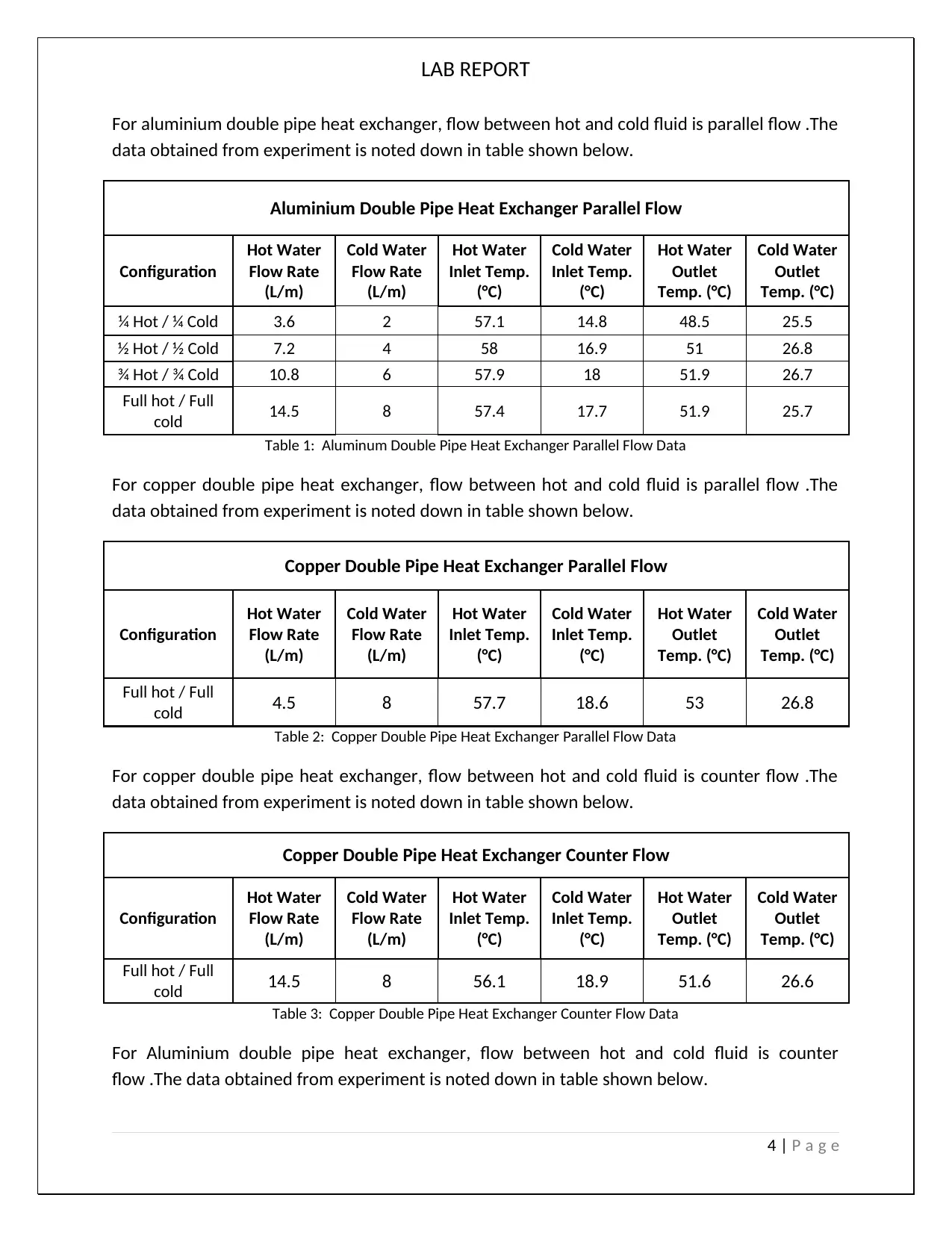
LAB REPORT
For aluminium double pipe heat exchanger, flow between hot and cold fluid is parallel flow .The
data obtained from experiment is noted down in table shown below.
Aluminium Double Pipe Heat Exchanger Parallel Flow
Configuration
Hot Water
Flow Rate
(L/m)
Cold Water
Flow Rate
(L/m)
Hot Water
Inlet Temp.
(°C)
Cold Water
Inlet Temp.
(°C)
Hot Water
Outlet
Temp. (°C)
Cold Water
Outlet
Temp. (°C)
¼ Hot / ¼ Cold 3.6 2 57.1 14.8 48.5 25.5
½ Hot / ½ Cold 7.2 4 58 16.9 51 26.8
¾ Hot / ¾ Cold 10.8 6 57.9 18 51.9 26.7
Full hot / Full
cold 14.5 8 57.4 17.7 51.9 25.7
Table 1: Aluminum Double Pipe Heat Exchanger Parallel Flow Data
For copper double pipe heat exchanger, flow between hot and cold fluid is parallel flow .The
data obtained from experiment is noted down in table shown below.
Copper Double Pipe Heat Exchanger Parallel Flow
Configuration
Hot Water
Flow Rate
(L/m)
Cold Water
Flow Rate
(L/m)
Hot Water
Inlet Temp.
(°C)
Cold Water
Inlet Temp.
(°C)
Hot Water
Outlet
Temp. (°C)
Cold Water
Outlet
Temp. (°C)
Full hot / Full
cold 4.5 8 57.7 18.6 53 26.8
Table 2: Copper Double Pipe Heat Exchanger Parallel Flow Data
For copper double pipe heat exchanger, flow between hot and cold fluid is counter flow .The
data obtained from experiment is noted down in table shown below.
Copper Double Pipe Heat Exchanger Counter Flow
Configuration
Hot Water
Flow Rate
(L/m)
Cold Water
Flow Rate
(L/m)
Hot Water
Inlet Temp.
(°C)
Cold Water
Inlet Temp.
(°C)
Hot Water
Outlet
Temp. (°C)
Cold Water
Outlet
Temp. (°C)
Full hot / Full
cold 14.5 8 56.1 18.9 51.6 26.6
Table 3: Copper Double Pipe Heat Exchanger Counter Flow Data
For Aluminium double pipe heat exchanger, flow between hot and cold fluid is counter
flow .The data obtained from experiment is noted down in table shown below.
4 | P a g e
For aluminium double pipe heat exchanger, flow between hot and cold fluid is parallel flow .The
data obtained from experiment is noted down in table shown below.
Aluminium Double Pipe Heat Exchanger Parallel Flow
Configuration
Hot Water
Flow Rate
(L/m)
Cold Water
Flow Rate
(L/m)
Hot Water
Inlet Temp.
(°C)
Cold Water
Inlet Temp.
(°C)
Hot Water
Outlet
Temp. (°C)
Cold Water
Outlet
Temp. (°C)
¼ Hot / ¼ Cold 3.6 2 57.1 14.8 48.5 25.5
½ Hot / ½ Cold 7.2 4 58 16.9 51 26.8
¾ Hot / ¾ Cold 10.8 6 57.9 18 51.9 26.7
Full hot / Full
cold 14.5 8 57.4 17.7 51.9 25.7
Table 1: Aluminum Double Pipe Heat Exchanger Parallel Flow Data
For copper double pipe heat exchanger, flow between hot and cold fluid is parallel flow .The
data obtained from experiment is noted down in table shown below.
Copper Double Pipe Heat Exchanger Parallel Flow
Configuration
Hot Water
Flow Rate
(L/m)
Cold Water
Flow Rate
(L/m)
Hot Water
Inlet Temp.
(°C)
Cold Water
Inlet Temp.
(°C)
Hot Water
Outlet
Temp. (°C)
Cold Water
Outlet
Temp. (°C)
Full hot / Full
cold 4.5 8 57.7 18.6 53 26.8
Table 2: Copper Double Pipe Heat Exchanger Parallel Flow Data
For copper double pipe heat exchanger, flow between hot and cold fluid is counter flow .The
data obtained from experiment is noted down in table shown below.
Copper Double Pipe Heat Exchanger Counter Flow
Configuration
Hot Water
Flow Rate
(L/m)
Cold Water
Flow Rate
(L/m)
Hot Water
Inlet Temp.
(°C)
Cold Water
Inlet Temp.
(°C)
Hot Water
Outlet
Temp. (°C)
Cold Water
Outlet
Temp. (°C)
Full hot / Full
cold 14.5 8 56.1 18.9 51.6 26.6
Table 3: Copper Double Pipe Heat Exchanger Counter Flow Data
For Aluminium double pipe heat exchanger, flow between hot and cold fluid is counter
flow .The data obtained from experiment is noted down in table shown below.
4 | P a g e
Secure Best Marks with AI Grader
Need help grading? Try our AI Grader for instant feedback on your assignments.
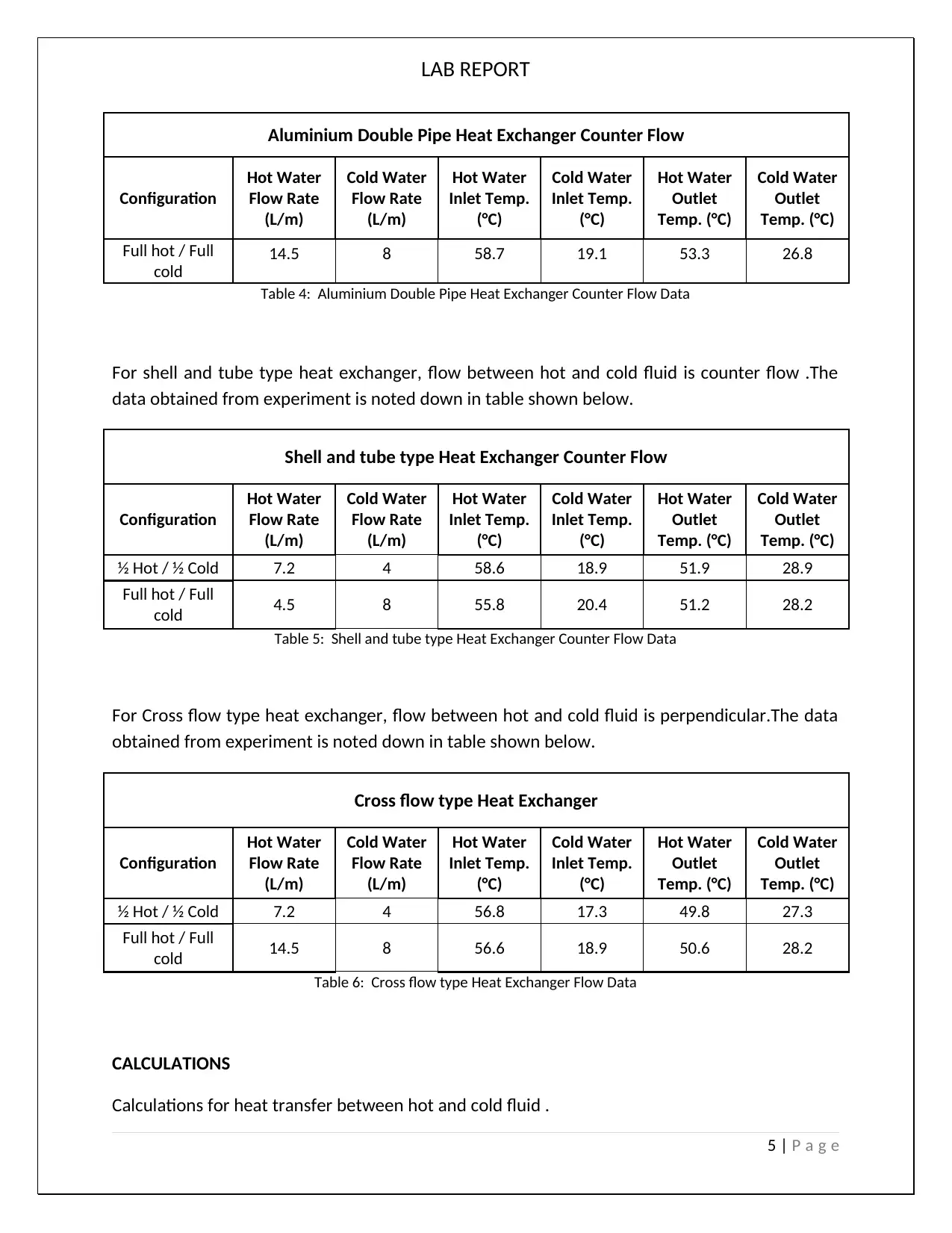
LAB REPORT
Aluminium Double Pipe Heat Exchanger Counter Flow
Configuration
Hot Water
Flow Rate
(L/m)
Cold Water
Flow Rate
(L/m)
Hot Water
Inlet Temp.
(°C)
Cold Water
Inlet Temp.
(°C)
Hot Water
Outlet
Temp. (°C)
Cold Water
Outlet
Temp. (°C)
Full hot / Full
cold
14.5 8 58.7 19.1 53.3 26.8
Table 4: Aluminium Double Pipe Heat Exchanger Counter Flow Data
For shell and tube type heat exchanger, flow between hot and cold fluid is counter flow .The
data obtained from experiment is noted down in table shown below.
Shell and tube type Heat Exchanger Counter Flow
Configuration
Hot Water
Flow Rate
(L/m)
Cold Water
Flow Rate
(L/m)
Hot Water
Inlet Temp.
(°C)
Cold Water
Inlet Temp.
(°C)
Hot Water
Outlet
Temp. (°C)
Cold Water
Outlet
Temp. (°C)
½ Hot / ½ Cold 7.2 4 58.6 18.9 51.9 28.9
Full hot / Full
cold 4.5 8 55.8 20.4 51.2 28.2
Table 5: Shell and tube type Heat Exchanger Counter Flow Data
For Cross flow type heat exchanger, flow between hot and cold fluid is perpendicular.The data
obtained from experiment is noted down in table shown below.
Cross flow type Heat Exchanger
Configuration
Hot Water
Flow Rate
(L/m)
Cold Water
Flow Rate
(L/m)
Hot Water
Inlet Temp.
(°C)
Cold Water
Inlet Temp.
(°C)
Hot Water
Outlet
Temp. (°C)
Cold Water
Outlet
Temp. (°C)
½ Hot / ½ Cold 7.2 4 56.8 17.3 49.8 27.3
Full hot / Full
cold 14.5 8 56.6 18.9 50.6 28.2
Table 6: Cross flow type Heat Exchanger Flow Data
CALCULATIONS
Calculations for heat transfer between hot and cold fluid .
5 | P a g e
Aluminium Double Pipe Heat Exchanger Counter Flow
Configuration
Hot Water
Flow Rate
(L/m)
Cold Water
Flow Rate
(L/m)
Hot Water
Inlet Temp.
(°C)
Cold Water
Inlet Temp.
(°C)
Hot Water
Outlet
Temp. (°C)
Cold Water
Outlet
Temp. (°C)
Full hot / Full
cold
14.5 8 58.7 19.1 53.3 26.8
Table 4: Aluminium Double Pipe Heat Exchanger Counter Flow Data
For shell and tube type heat exchanger, flow between hot and cold fluid is counter flow .The
data obtained from experiment is noted down in table shown below.
Shell and tube type Heat Exchanger Counter Flow
Configuration
Hot Water
Flow Rate
(L/m)
Cold Water
Flow Rate
(L/m)
Hot Water
Inlet Temp.
(°C)
Cold Water
Inlet Temp.
(°C)
Hot Water
Outlet
Temp. (°C)
Cold Water
Outlet
Temp. (°C)
½ Hot / ½ Cold 7.2 4 58.6 18.9 51.9 28.9
Full hot / Full
cold 4.5 8 55.8 20.4 51.2 28.2
Table 5: Shell and tube type Heat Exchanger Counter Flow Data
For Cross flow type heat exchanger, flow between hot and cold fluid is perpendicular.The data
obtained from experiment is noted down in table shown below.
Cross flow type Heat Exchanger
Configuration
Hot Water
Flow Rate
(L/m)
Cold Water
Flow Rate
(L/m)
Hot Water
Inlet Temp.
(°C)
Cold Water
Inlet Temp.
(°C)
Hot Water
Outlet
Temp. (°C)
Cold Water
Outlet
Temp. (°C)
½ Hot / ½ Cold 7.2 4 56.8 17.3 49.8 27.3
Full hot / Full
cold 14.5 8 56.6 18.9 50.6 28.2
Table 6: Cross flow type Heat Exchanger Flow Data
CALCULATIONS
Calculations for heat transfer between hot and cold fluid .
5 | P a g e
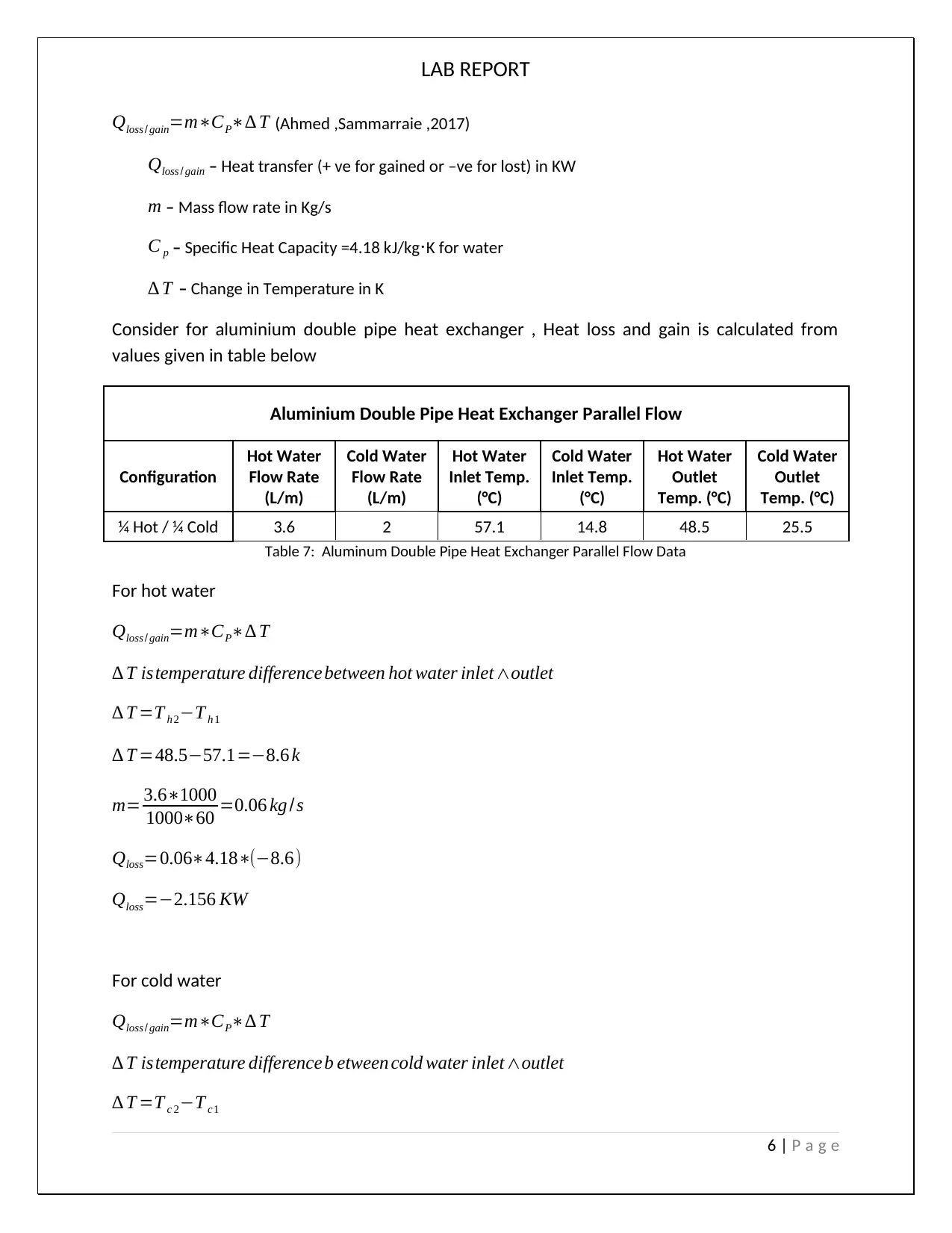
LAB REPORT
Qloss / gain=m∗CP∗∆ T (Ahmed ,Sammarraie ,2017)
Qloss / gain – Heat transfer (+ ve for gained or –ve for lost) in KW
m – Mass flow rate in Kg/s
C p – Specific Heat Capacity =4.18 kJ/kg⋅K for water
∆ T – Change in Temperature in K
Consider for aluminium double pipe heat exchanger , Heat loss and gain is calculated from
values given in table below
Aluminium Double Pipe Heat Exchanger Parallel Flow
Configuration
Hot Water
Flow Rate
(L/m)
Cold Water
Flow Rate
(L/m)
Hot Water
Inlet Temp.
(°C)
Cold Water
Inlet Temp.
(°C)
Hot Water
Outlet
Temp. (°C)
Cold Water
Outlet
Temp. (°C)
¼ Hot / ¼ Cold 3.6 2 57.1 14.8 48.5 25.5
Table 7: Aluminum Double Pipe Heat Exchanger Parallel Flow Data
For hot water
Qloss / gain=m∗CP∗∆ T
∆ T istemperature difference between hot water inlet ∧outlet
∆ T =T h 2−T h 1
∆ T =48.5−57.1=−8.6 k
m= 3.6∗1000
1000∗60 =0.06 kg /s
Qloss=0.06∗4.18∗(−8.6)
Qloss=−2.156 KW
For cold water
Qloss / gain=m∗CP∗∆ T
∆ T istemperature difference b etween cold water inlet∧outlet
∆ T =T c 2−T c1
6 | P a g e
Qloss / gain=m∗CP∗∆ T (Ahmed ,Sammarraie ,2017)
Qloss / gain – Heat transfer (+ ve for gained or –ve for lost) in KW
m – Mass flow rate in Kg/s
C p – Specific Heat Capacity =4.18 kJ/kg⋅K for water
∆ T – Change in Temperature in K
Consider for aluminium double pipe heat exchanger , Heat loss and gain is calculated from
values given in table below
Aluminium Double Pipe Heat Exchanger Parallel Flow
Configuration
Hot Water
Flow Rate
(L/m)
Cold Water
Flow Rate
(L/m)
Hot Water
Inlet Temp.
(°C)
Cold Water
Inlet Temp.
(°C)
Hot Water
Outlet
Temp. (°C)
Cold Water
Outlet
Temp. (°C)
¼ Hot / ¼ Cold 3.6 2 57.1 14.8 48.5 25.5
Table 7: Aluminum Double Pipe Heat Exchanger Parallel Flow Data
For hot water
Qloss / gain=m∗CP∗∆ T
∆ T istemperature difference between hot water inlet ∧outlet
∆ T =T h 2−T h 1
∆ T =48.5−57.1=−8.6 k
m= 3.6∗1000
1000∗60 =0.06 kg /s
Qloss=0.06∗4.18∗(−8.6)
Qloss=−2.156 KW
For cold water
Qloss / gain=m∗CP∗∆ T
∆ T istemperature difference b etween cold water inlet∧outlet
∆ T =T c 2−T c1
6 | P a g e
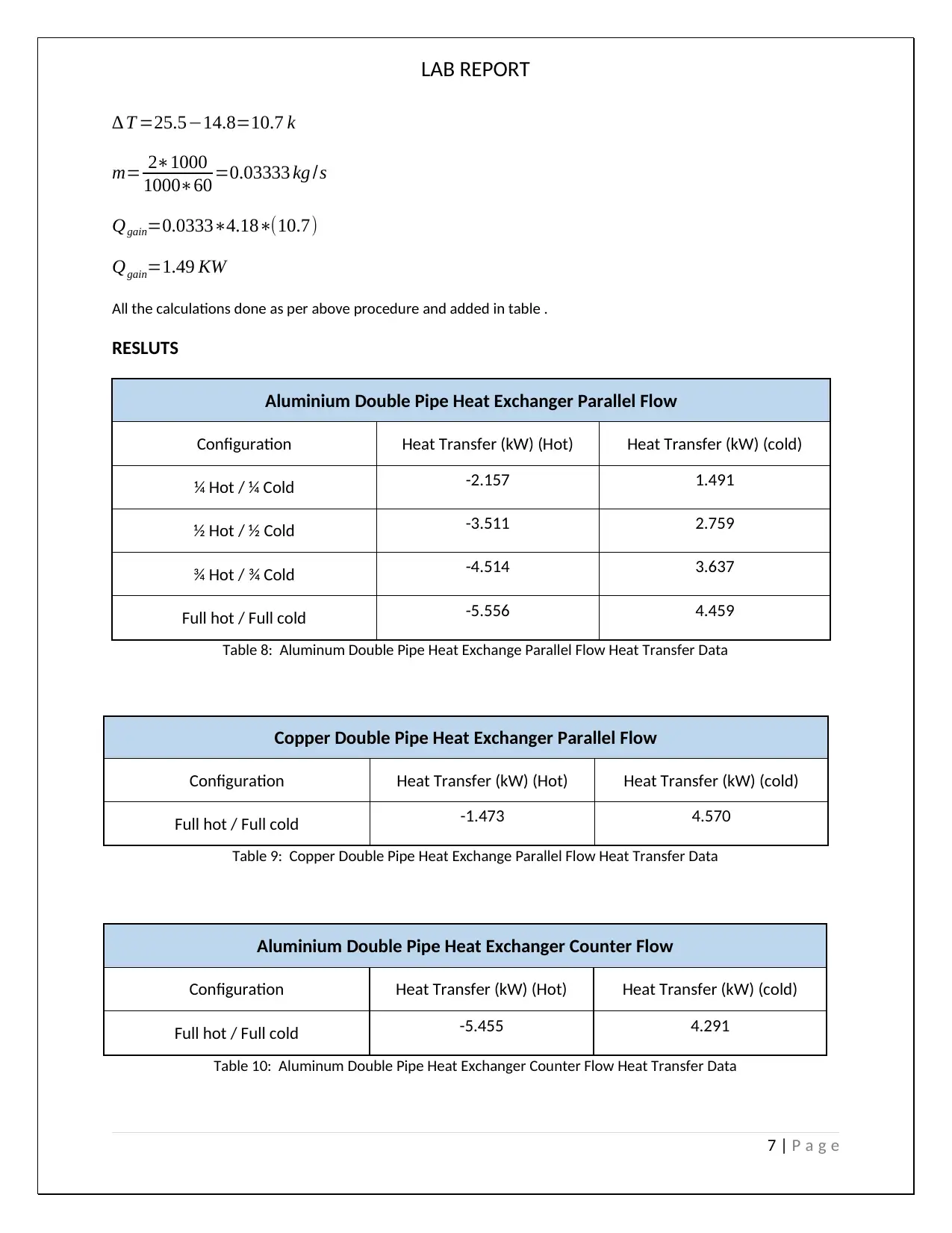
LAB REPORT
∆ T =25.5−14.8=10.7 k
m= 2∗1000
1000∗60 =0.03333 kg /s
Qgain=0.0333∗4.18∗(10.7)
Qgain=1.49 KW
All the calculations done as per above procedure and added in table .
RESLUTS
Aluminium Double Pipe Heat Exchanger Parallel Flow
Configuration Heat Transfer (kW) (Hot) Heat Transfer (kW) (cold)
¼ Hot / ¼ Cold -2.157 1.491
½ Hot / ½ Cold -3.511 2.759
¾ Hot / ¾ Cold -4.514 3.637
Full hot / Full cold -5.556 4.459
Table 8: Aluminum Double Pipe Heat Exchange Parallel Flow Heat Transfer Data
Copper Double Pipe Heat Exchanger Parallel Flow
Configuration Heat Transfer (kW) (Hot) Heat Transfer (kW) (cold)
Full hot / Full cold -1.473 4.570
Table 9: Copper Double Pipe Heat Exchange Parallel Flow Heat Transfer Data
Aluminium Double Pipe Heat Exchanger Counter Flow
Configuration Heat Transfer (kW) (Hot) Heat Transfer (kW) (cold)
Full hot / Full cold -5.455 4.291
Table 10: Aluminum Double Pipe Heat Exchanger Counter Flow Heat Transfer Data
7 | P a g e
∆ T =25.5−14.8=10.7 k
m= 2∗1000
1000∗60 =0.03333 kg /s
Qgain=0.0333∗4.18∗(10.7)
Qgain=1.49 KW
All the calculations done as per above procedure and added in table .
RESLUTS
Aluminium Double Pipe Heat Exchanger Parallel Flow
Configuration Heat Transfer (kW) (Hot) Heat Transfer (kW) (cold)
¼ Hot / ¼ Cold -2.157 1.491
½ Hot / ½ Cold -3.511 2.759
¾ Hot / ¾ Cold -4.514 3.637
Full hot / Full cold -5.556 4.459
Table 8: Aluminum Double Pipe Heat Exchange Parallel Flow Heat Transfer Data
Copper Double Pipe Heat Exchanger Parallel Flow
Configuration Heat Transfer (kW) (Hot) Heat Transfer (kW) (cold)
Full hot / Full cold -1.473 4.570
Table 9: Copper Double Pipe Heat Exchange Parallel Flow Heat Transfer Data
Aluminium Double Pipe Heat Exchanger Counter Flow
Configuration Heat Transfer (kW) (Hot) Heat Transfer (kW) (cold)
Full hot / Full cold -5.455 4.291
Table 10: Aluminum Double Pipe Heat Exchanger Counter Flow Heat Transfer Data
7 | P a g e
Paraphrase This Document
Need a fresh take? Get an instant paraphrase of this document with our AI Paraphraser
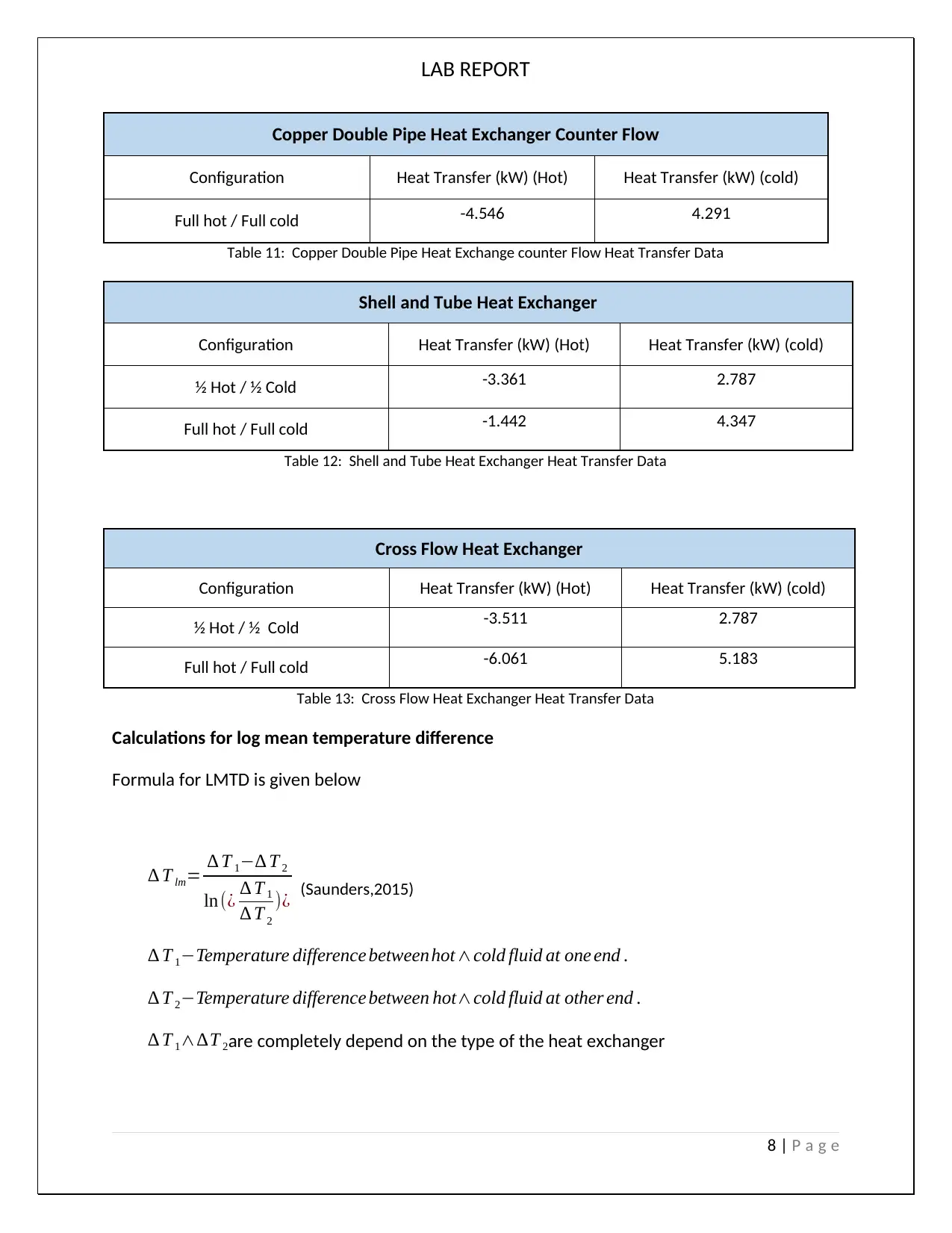
LAB REPORT
Copper Double Pipe Heat Exchanger Counter Flow
Configuration Heat Transfer (kW) (Hot) Heat Transfer (kW) (cold)
Full hot / Full cold -4.546 4.291
Table 11: Copper Double Pipe Heat Exchange counter Flow Heat Transfer Data
Shell and Tube Heat Exchanger
Configuration Heat Transfer (kW) (Hot) Heat Transfer (kW) (cold)
½ Hot / ½ Cold -3.361 2.787
Full hot / Full cold -1.442 4.347
Table 12: Shell and Tube Heat Exchanger Heat Transfer Data
Cross Flow Heat Exchanger
Configuration Heat Transfer (kW) (Hot) Heat Transfer (kW) (cold)
½ Hot / ½ Cold -3.511 2.787
Full hot / Full cold -6.061 5.183
Table 13: Cross Flow Heat Exchanger Heat Transfer Data
Calculations for log mean temperature difference
Formula for LMTD is given below
∆ T lm= ∆ T 1−∆ T 2
ln (¿ ∆ T 1
∆ T 2
)¿ (Saunders,2015)
∆ T 1−Temperature difference between hot∧cold fluid at one end .
∆ T 2−Temperature difference between hot∧cold fluid at other end .
∆ T 1∧∆T 2are completely depend on the type of the heat exchanger
8 | P a g e
Copper Double Pipe Heat Exchanger Counter Flow
Configuration Heat Transfer (kW) (Hot) Heat Transfer (kW) (cold)
Full hot / Full cold -4.546 4.291
Table 11: Copper Double Pipe Heat Exchange counter Flow Heat Transfer Data
Shell and Tube Heat Exchanger
Configuration Heat Transfer (kW) (Hot) Heat Transfer (kW) (cold)
½ Hot / ½ Cold -3.361 2.787
Full hot / Full cold -1.442 4.347
Table 12: Shell and Tube Heat Exchanger Heat Transfer Data
Cross Flow Heat Exchanger
Configuration Heat Transfer (kW) (Hot) Heat Transfer (kW) (cold)
½ Hot / ½ Cold -3.511 2.787
Full hot / Full cold -6.061 5.183
Table 13: Cross Flow Heat Exchanger Heat Transfer Data
Calculations for log mean temperature difference
Formula for LMTD is given below
∆ T lm= ∆ T 1−∆ T 2
ln (¿ ∆ T 1
∆ T 2
)¿ (Saunders,2015)
∆ T 1−Temperature difference between hot∧cold fluid at one end .
∆ T 2−Temperature difference between hot∧cold fluid at other end .
∆ T 1∧∆T 2are completely depend on the type of the heat exchanger
8 | P a g e
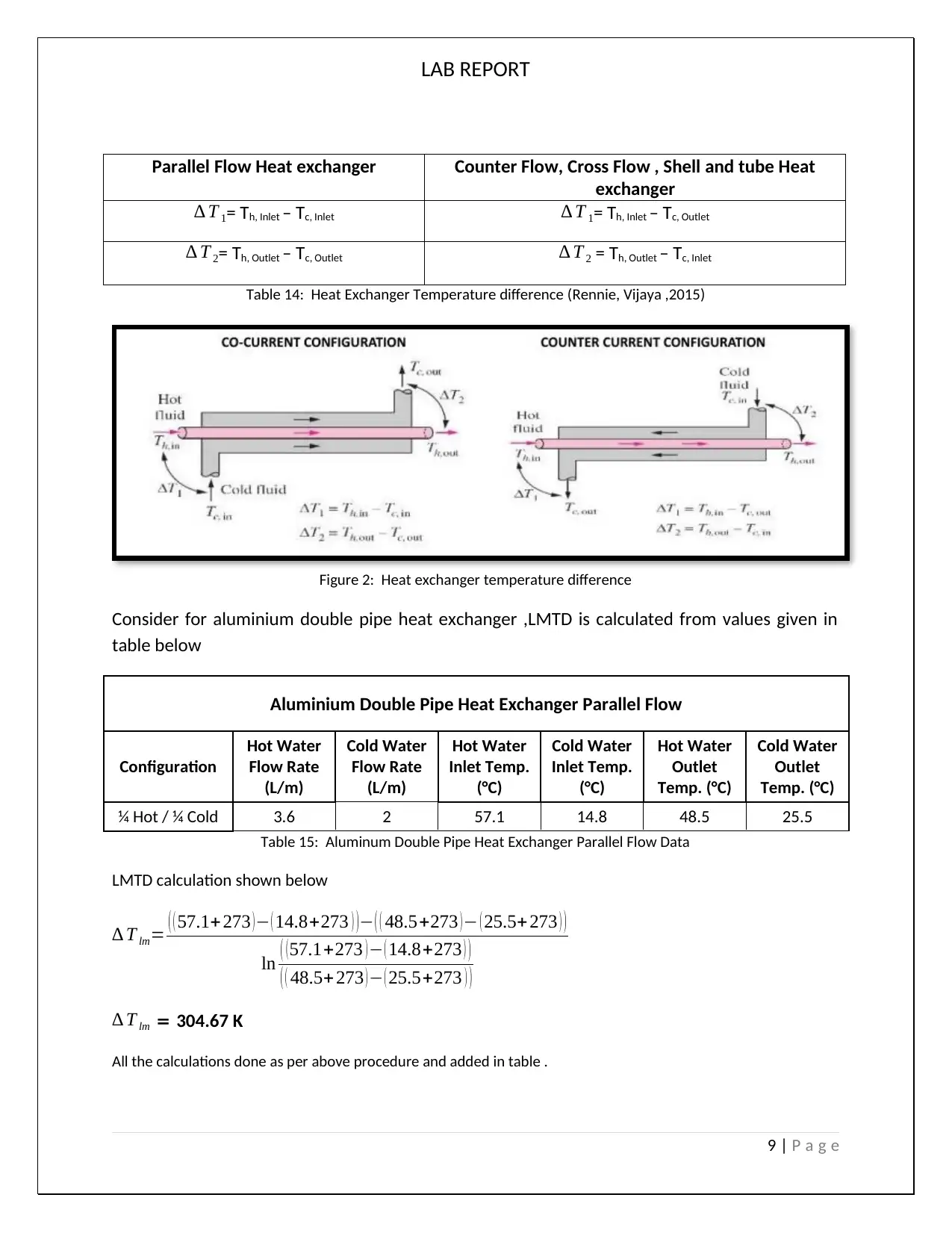
LAB REPORT
Parallel Flow Heat exchanger Counter Flow, Cross Flow , Shell and tube Heat
exchanger
∆ T 1= Th, Inlet – Tc, Inlet ∆ T 1= Th, Inlet – Tc, Outlet
∆ T 2= Th, Outlet – Tc, Outlet ∆ T 2 = Th, Outlet – Tc, Inlet
Table 14: Heat Exchanger Temperature difference (Rennie, Vijaya ,2015)
Figure 2: Heat exchanger temperature difference
Consider for aluminium double pipe heat exchanger ,LMTD is calculated from values given in
table below
Aluminium Double Pipe Heat Exchanger Parallel Flow
Configuration
Hot Water
Flow Rate
(L/m)
Cold Water
Flow Rate
(L/m)
Hot Water
Inlet Temp.
(°C)
Cold Water
Inlet Temp.
(°C)
Hot Water
Outlet
Temp. (°C)
Cold Water
Outlet
Temp. (°C)
¼ Hot / ¼ Cold 3.6 2 57.1 14.8 48.5 25.5
Table 15: Aluminum Double Pipe Heat Exchanger Parallel Flow Data
LMTD calculation shown below
∆ T lm= ( ( 57.1+ 273 )− ( 14.8+273 ) )− ( ( 48.5+273 )− ( 25.5+ 273 ) )
ln ( (57.1+273 )− ( 14.8+273 ) )
( ( 48.5+273 )− ( 25.5+273 ) )
∆ T lm = 304.67 K
All the calculations done as per above procedure and added in table .
9 | P a g e
Parallel Flow Heat exchanger Counter Flow, Cross Flow , Shell and tube Heat
exchanger
∆ T 1= Th, Inlet – Tc, Inlet ∆ T 1= Th, Inlet – Tc, Outlet
∆ T 2= Th, Outlet – Tc, Outlet ∆ T 2 = Th, Outlet – Tc, Inlet
Table 14: Heat Exchanger Temperature difference (Rennie, Vijaya ,2015)
Figure 2: Heat exchanger temperature difference
Consider for aluminium double pipe heat exchanger ,LMTD is calculated from values given in
table below
Aluminium Double Pipe Heat Exchanger Parallel Flow
Configuration
Hot Water
Flow Rate
(L/m)
Cold Water
Flow Rate
(L/m)
Hot Water
Inlet Temp.
(°C)
Cold Water
Inlet Temp.
(°C)
Hot Water
Outlet
Temp. (°C)
Cold Water
Outlet
Temp. (°C)
¼ Hot / ¼ Cold 3.6 2 57.1 14.8 48.5 25.5
Table 15: Aluminum Double Pipe Heat Exchanger Parallel Flow Data
LMTD calculation shown below
∆ T lm= ( ( 57.1+ 273 )− ( 14.8+273 ) )− ( ( 48.5+273 )− ( 25.5+ 273 ) )
ln ( (57.1+273 )− ( 14.8+273 ) )
( ( 48.5+273 )− ( 25.5+273 ) )
∆ T lm = 304.67 K
All the calculations done as per above procedure and added in table .
9 | P a g e
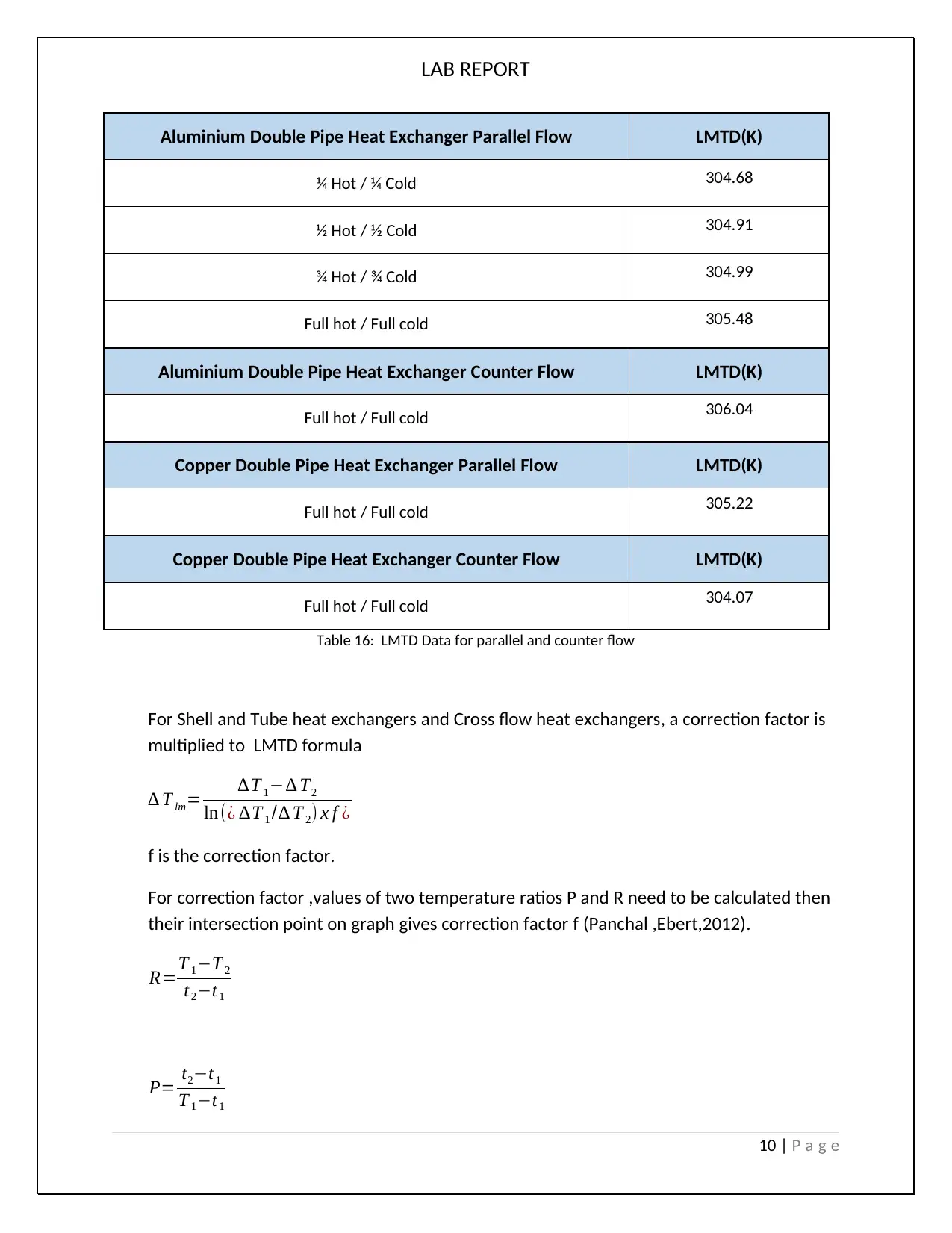
LAB REPORT
Aluminium Double Pipe Heat Exchanger Parallel Flow LMTD(K)
¼ Hot / ¼ Cold 304.68
½ Hot / ½ Cold 304.91
¾ Hot / ¾ Cold 304.99
Full hot / Full cold 305.48
Aluminium Double Pipe Heat Exchanger Counter Flow LMTD(K)
Full hot / Full cold 306.04
Copper Double Pipe Heat Exchanger Parallel Flow LMTD(K)
Full hot / Full cold 305.22
Copper Double Pipe Heat Exchanger Counter Flow LMTD(K)
Full hot / Full cold 304.07
Table 16: LMTD Data for parallel and counter flow
For Shell and Tube heat exchangers and Cross flow heat exchangers, a correction factor is
multiplied to LMTD formula
∆ T lm= ∆T 1−∆ T2
ln(¿ ∆T 1 /∆ T 2) x f ¿
f is the correction factor.
For correction factor ,values of two temperature ratios P and R need to be calculated then
their intersection point on graph gives correction factor f (Panchal ,Ebert,2012).
R=T 1−T 2
t2−t1
P= t2−t1
T 1−t1
10 | P a g e
Aluminium Double Pipe Heat Exchanger Parallel Flow LMTD(K)
¼ Hot / ¼ Cold 304.68
½ Hot / ½ Cold 304.91
¾ Hot / ¾ Cold 304.99
Full hot / Full cold 305.48
Aluminium Double Pipe Heat Exchanger Counter Flow LMTD(K)
Full hot / Full cold 306.04
Copper Double Pipe Heat Exchanger Parallel Flow LMTD(K)
Full hot / Full cold 305.22
Copper Double Pipe Heat Exchanger Counter Flow LMTD(K)
Full hot / Full cold 304.07
Table 16: LMTD Data for parallel and counter flow
For Shell and Tube heat exchangers and Cross flow heat exchangers, a correction factor is
multiplied to LMTD formula
∆ T lm= ∆T 1−∆ T2
ln(¿ ∆T 1 /∆ T 2) x f ¿
f is the correction factor.
For correction factor ,values of two temperature ratios P and R need to be calculated then
their intersection point on graph gives correction factor f (Panchal ,Ebert,2012).
R=T 1−T 2
t2−t1
P= t2−t1
T 1−t1
10 | P a g e
Secure Best Marks with AI Grader
Need help grading? Try our AI Grader for instant feedback on your assignments.
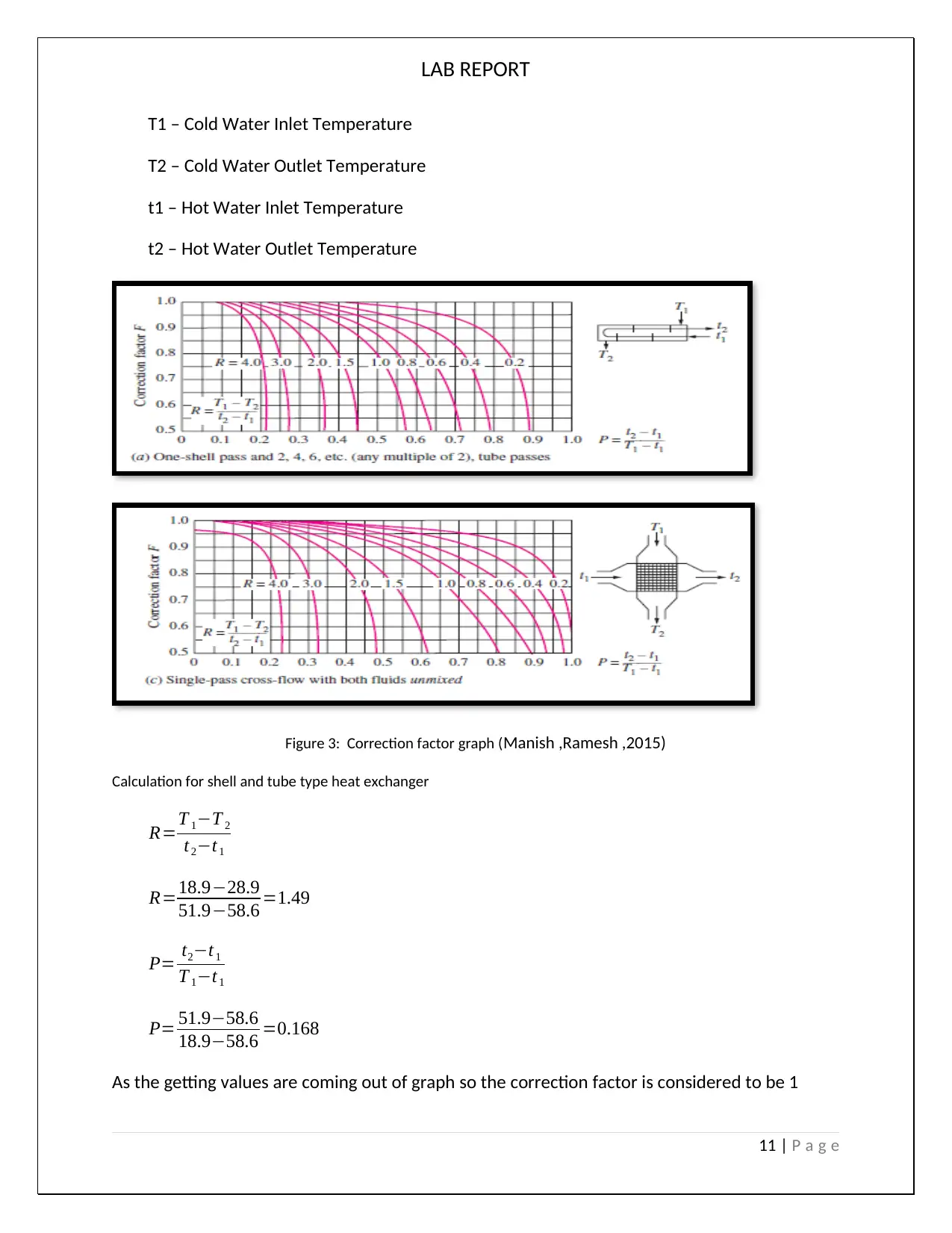
LAB REPORT
T1 – Cold Water Inlet Temperature
T2 – Cold Water Outlet Temperature
t1 – Hot Water Inlet Temperature
t2 – Hot Water Outlet Temperature
Figure 3: Correction factor graph (Manish ,Ramesh ,2015)
Calculation for shell and tube type heat exchanger
R=T 1−T 2
t2−t1
R=18.9−28.9
51.9−58.6 =1.49
P= t2−t1
T 1−t1
P= 51.9−58.6
18.9−58.6 =0.168
As the getting values are coming out of graph so the correction factor is considered to be 1
11 | P a g e
T1 – Cold Water Inlet Temperature
T2 – Cold Water Outlet Temperature
t1 – Hot Water Inlet Temperature
t2 – Hot Water Outlet Temperature
Figure 3: Correction factor graph (Manish ,Ramesh ,2015)
Calculation for shell and tube type heat exchanger
R=T 1−T 2
t2−t1
R=18.9−28.9
51.9−58.6 =1.49
P= t2−t1
T 1−t1
P= 51.9−58.6
18.9−58.6 =0.168
As the getting values are coming out of graph so the correction factor is considered to be 1
11 | P a g e
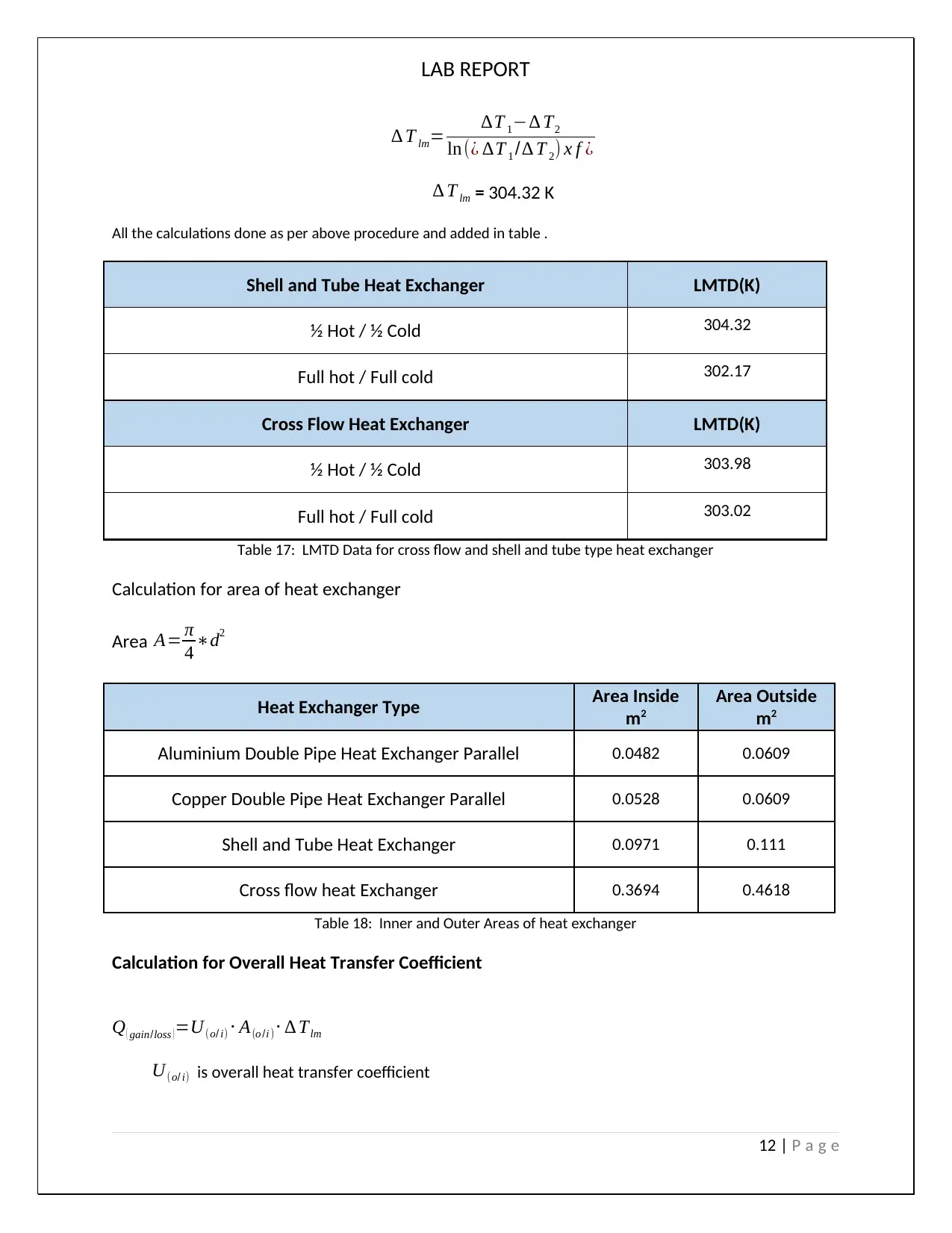
LAB REPORT
∆ T lm= ∆T 1−∆ T2
ln(¿ ∆T 1 /∆ T 2) x f ¿
∆ T lm = 304.32 K
All the calculations done as per above procedure and added in table .
Shell and Tube Heat Exchanger LMTD(K)
½ Hot / ½ Cold 304.32
Full hot / Full cold 302.17
Cross Flow Heat Exchanger LMTD(K)
½ Hot / ½ Cold 303.98
Full hot / Full cold 303.02
Table 17: LMTD Data for cross flow and shell and tube type heat exchanger
Calculation for area of heat exchanger
Area A= π
4 ∗d2
Heat Exchanger Type Area Inside
m2
Area Outside
m2
Aluminium Double Pipe Heat Exchanger Parallel 0.0482 0.0609
Copper Double Pipe Heat Exchanger Parallel 0.0528 0.0609
Shell and Tube Heat Exchanger 0.0971 0.111
Cross flow heat Exchanger 0.3694 0.4618
Table 18: Inner and Outer Areas of heat exchanger
Calculation for Overall Heat Transfer Coefficient
Q ( gain/loss ) =U(o/ i) ⋅ A(o /i )⋅ ∆ Tlm
U(o/ i) is overall heat transfer coefficient
12 | P a g e
∆ T lm= ∆T 1−∆ T2
ln(¿ ∆T 1 /∆ T 2) x f ¿
∆ T lm = 304.32 K
All the calculations done as per above procedure and added in table .
Shell and Tube Heat Exchanger LMTD(K)
½ Hot / ½ Cold 304.32
Full hot / Full cold 302.17
Cross Flow Heat Exchanger LMTD(K)
½ Hot / ½ Cold 303.98
Full hot / Full cold 303.02
Table 17: LMTD Data for cross flow and shell and tube type heat exchanger
Calculation for area of heat exchanger
Area A= π
4 ∗d2
Heat Exchanger Type Area Inside
m2
Area Outside
m2
Aluminium Double Pipe Heat Exchanger Parallel 0.0482 0.0609
Copper Double Pipe Heat Exchanger Parallel 0.0528 0.0609
Shell and Tube Heat Exchanger 0.0971 0.111
Cross flow heat Exchanger 0.3694 0.4618
Table 18: Inner and Outer Areas of heat exchanger
Calculation for Overall Heat Transfer Coefficient
Q ( gain/loss ) =U(o/ i) ⋅ A(o /i )⋅ ∆ Tlm
U(o/ i) is overall heat transfer coefficient
12 | P a g e
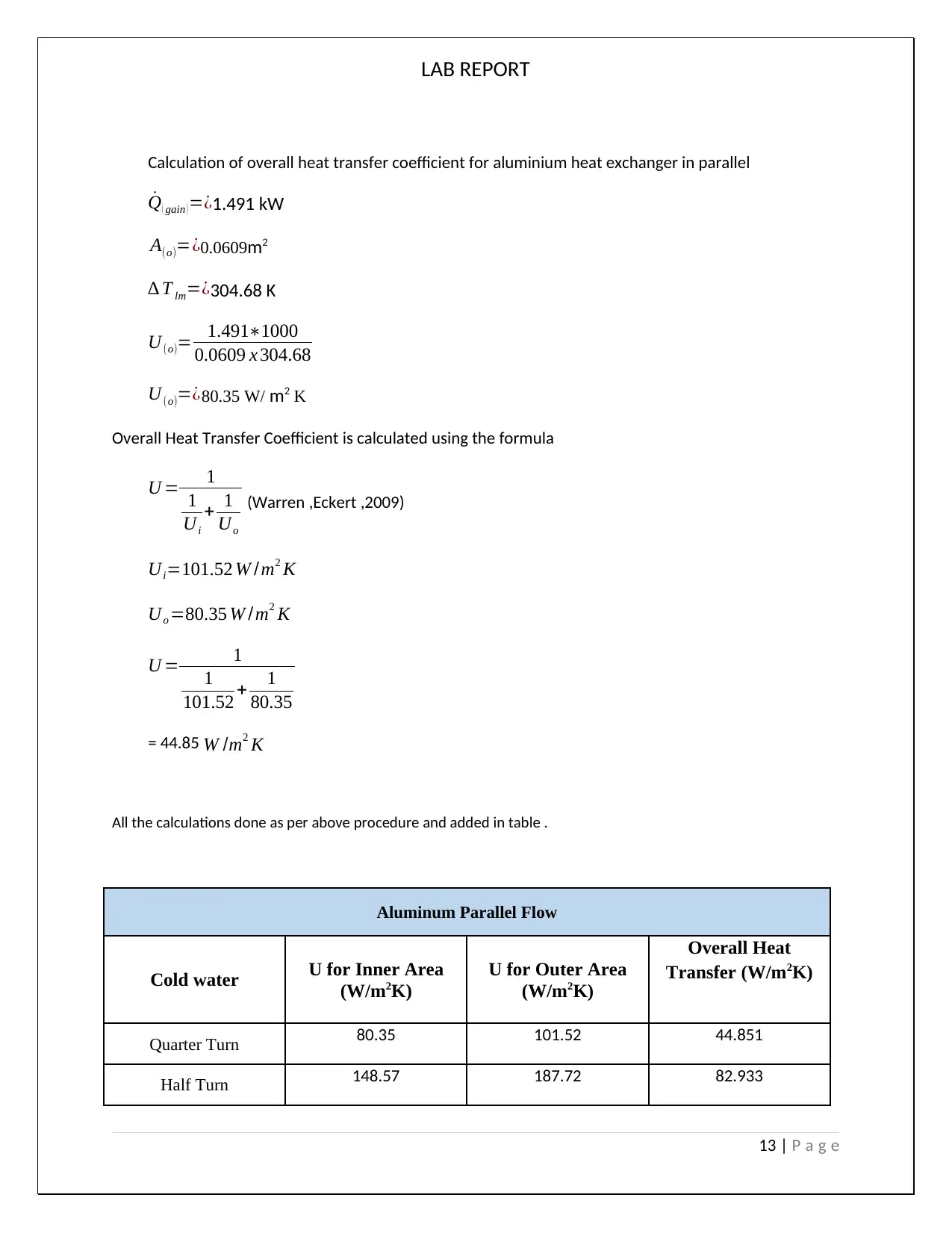
LAB REPORT
Calculation of overall heat transfer coefficient for aluminium heat exchanger in parallel
˙Q ( gain ) =¿1.491 kW
A(o)=¿0.0609m2
∆ T lm=¿304.68 K
U(o)= 1.491∗1000
0.0609 x 304.68
U(o)=¿80.35 W/ m2 K
Overall Heat Transfer Coefficient is calculated using the formula
U = 1
1
Ui
+ 1
Uo
(Warren ,Eckert ,2009)
Ui=101.52 W /m2 K
Uo =80.35 W /m2 K
U = 1
1
101.52 + 1
80.35
= 44.85 W /m2 K
All the calculations done as per above procedure and added in table .
Aluminum Parallel Flow
Cold water U for Inner Area
(W/m2K)
U for Outer Area
(W/m2K)
Overall Heat
Transfer (W/m2K)
Quarter Turn 80.35 101.52 44.851
Half Turn 148.57 187.72 82.933
13 | P a g e
Calculation of overall heat transfer coefficient for aluminium heat exchanger in parallel
˙Q ( gain ) =¿1.491 kW
A(o)=¿0.0609m2
∆ T lm=¿304.68 K
U(o)= 1.491∗1000
0.0609 x 304.68
U(o)=¿80.35 W/ m2 K
Overall Heat Transfer Coefficient is calculated using the formula
U = 1
1
Ui
+ 1
Uo
(Warren ,Eckert ,2009)
Ui=101.52 W /m2 K
Uo =80.35 W /m2 K
U = 1
1
101.52 + 1
80.35
= 44.85 W /m2 K
All the calculations done as per above procedure and added in table .
Aluminum Parallel Flow
Cold water U for Inner Area
(W/m2K)
U for Outer Area
(W/m2K)
Overall Heat
Transfer (W/m2K)
Quarter Turn 80.35 101.52 44.851
Half Turn 148.57 187.72 82.933
13 | P a g e
Paraphrase This Document
Need a fresh take? Get an instant paraphrase of this document with our AI Paraphraser
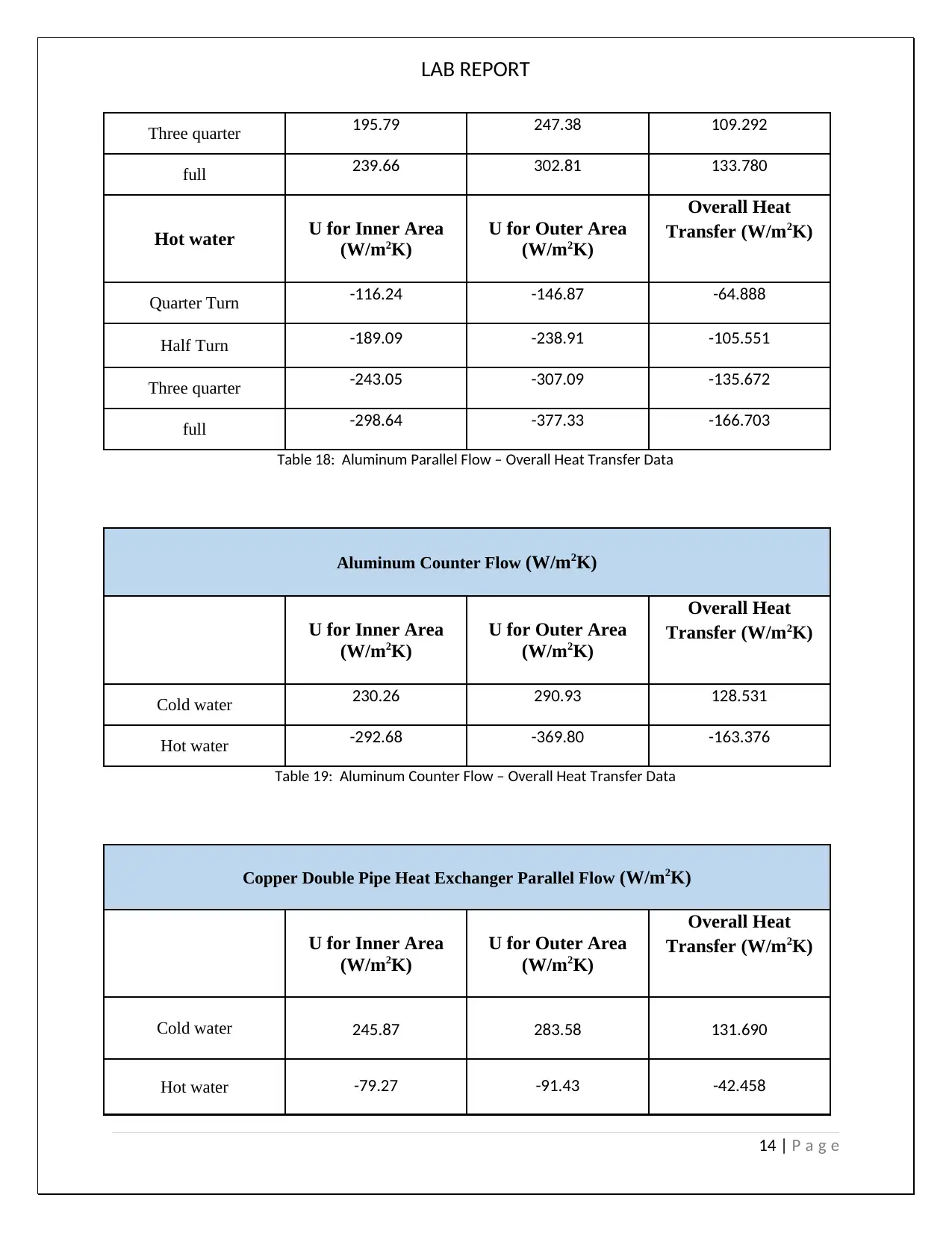
LAB REPORT
Three quarter 195.79 247.38 109.292
full 239.66 302.81 133.780
Hot water U for Inner Area
(W/m2K)
U for Outer Area
(W/m2K)
Overall Heat
Transfer (W/m2K)
Quarter Turn -116.24 -146.87 -64.888
Half Turn -189.09 -238.91 -105.551
Three quarter -243.05 -307.09 -135.672
full -298.64 -377.33 -166.703
Table 18: Aluminum Parallel Flow – Overall Heat Transfer Data
Aluminum Counter Flow (W/m2K)
U for Inner Area
(W/m2K)
U for Outer Area
(W/m2K)
Overall Heat
Transfer (W/m2K)
Cold water 230.26 290.93 128.531
Hot water -292.68 -369.80 -163.376
Table 19: Aluminum Counter Flow – Overall Heat Transfer Data
Copper Double Pipe Heat Exchanger Parallel Flow (W/m2K)
U for Inner Area
(W/m2K)
U for Outer Area
(W/m2K)
Overall Heat
Transfer (W/m2K)
Cold water 245.87 283.58 131.690
Hot water -79.27 -91.43 -42.458
14 | P a g e
Three quarter 195.79 247.38 109.292
full 239.66 302.81 133.780
Hot water U for Inner Area
(W/m2K)
U for Outer Area
(W/m2K)
Overall Heat
Transfer (W/m2K)
Quarter Turn -116.24 -146.87 -64.888
Half Turn -189.09 -238.91 -105.551
Three quarter -243.05 -307.09 -135.672
full -298.64 -377.33 -166.703
Table 18: Aluminum Parallel Flow – Overall Heat Transfer Data
Aluminum Counter Flow (W/m2K)
U for Inner Area
(W/m2K)
U for Outer Area
(W/m2K)
Overall Heat
Transfer (W/m2K)
Cold water 230.26 290.93 128.531
Hot water -292.68 -369.80 -163.376
Table 19: Aluminum Counter Flow – Overall Heat Transfer Data
Copper Double Pipe Heat Exchanger Parallel Flow (W/m2K)
U for Inner Area
(W/m2K)
U for Outer Area
(W/m2K)
Overall Heat
Transfer (W/m2K)
Cold water 245.87 283.58 131.690
Hot water -79.27 -91.43 -42.458
14 | P a g e
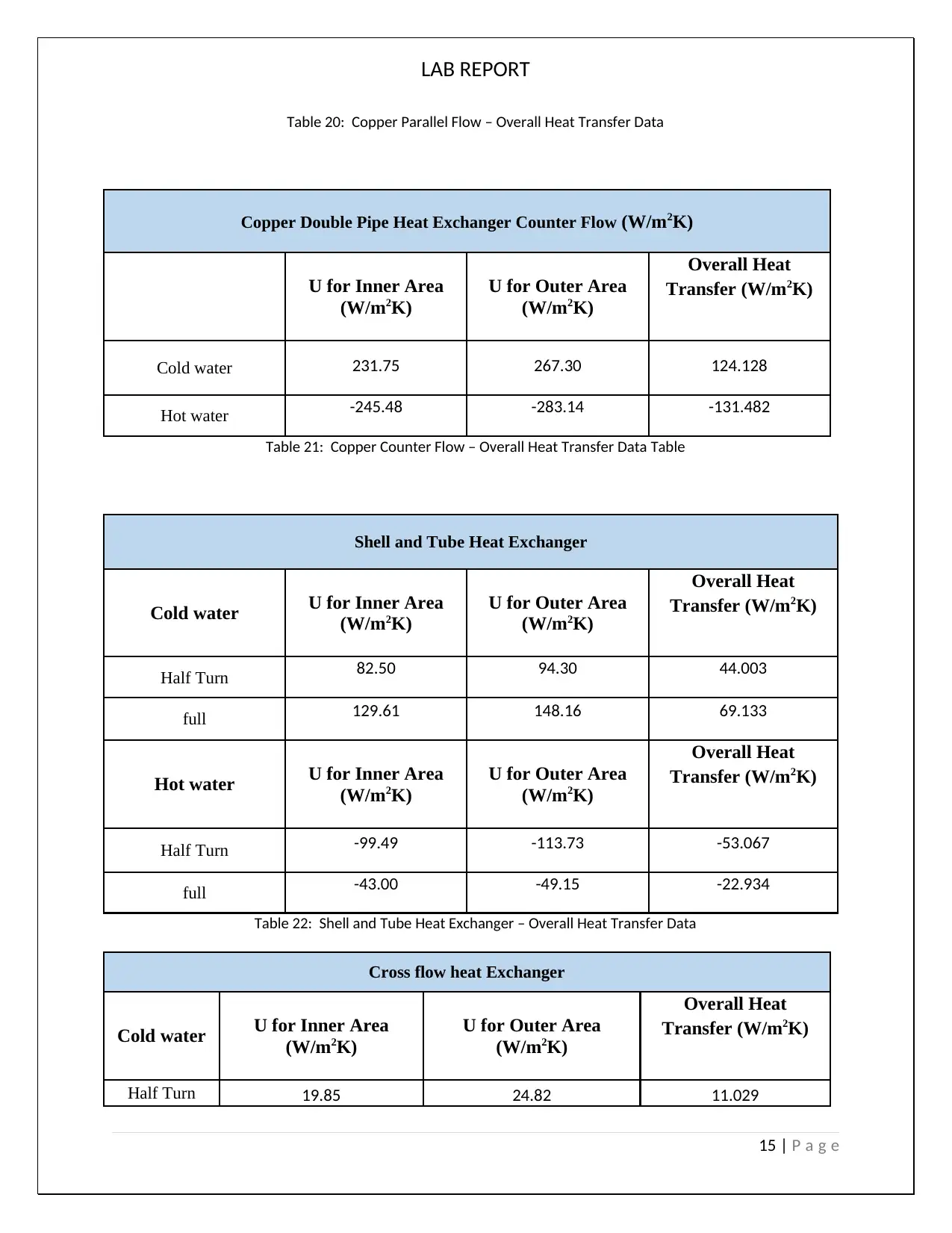
LAB REPORT
Table 20: Copper Parallel Flow – Overall Heat Transfer Data
Copper Double Pipe Heat Exchanger Counter Flow (W/m2K)
U for Inner Area
(W/m2K)
U for Outer Area
(W/m2K)
Overall Heat
Transfer (W/m2K)
Cold water 231.75 267.30 124.128
Hot water -245.48 -283.14 -131.482
Table 21: Copper Counter Flow – Overall Heat Transfer Data Table
Shell and Tube Heat Exchanger
Cold water U for Inner Area
(W/m2K)
U for Outer Area
(W/m2K)
Overall Heat
Transfer (W/m2K)
Half Turn 82.50 94.30 44.003
full 129.61 148.16 69.133
Hot water U for Inner Area
(W/m2K)
U for Outer Area
(W/m2K)
Overall Heat
Transfer (W/m2K)
Half Turn -99.49 -113.73 -53.067
full -43.00 -49.15 -22.934
Table 22: Shell and Tube Heat Exchanger – Overall Heat Transfer Data
Cross flow heat Exchanger
Cold water U for Inner Area
(W/m2K)
U for Outer Area
(W/m2K)
Overall Heat
Transfer (W/m2K)
Half Turn 19.85 24.82 11.029
15 | P a g e
Table 20: Copper Parallel Flow – Overall Heat Transfer Data
Copper Double Pipe Heat Exchanger Counter Flow (W/m2K)
U for Inner Area
(W/m2K)
U for Outer Area
(W/m2K)
Overall Heat
Transfer (W/m2K)
Cold water 231.75 267.30 124.128
Hot water -245.48 -283.14 -131.482
Table 21: Copper Counter Flow – Overall Heat Transfer Data Table
Shell and Tube Heat Exchanger
Cold water U for Inner Area
(W/m2K)
U for Outer Area
(W/m2K)
Overall Heat
Transfer (W/m2K)
Half Turn 82.50 94.30 44.003
full 129.61 148.16 69.133
Hot water U for Inner Area
(W/m2K)
U for Outer Area
(W/m2K)
Overall Heat
Transfer (W/m2K)
Half Turn -99.49 -113.73 -53.067
full -43.00 -49.15 -22.934
Table 22: Shell and Tube Heat Exchanger – Overall Heat Transfer Data
Cross flow heat Exchanger
Cold water U for Inner Area
(W/m2K)
U for Outer Area
(W/m2K)
Overall Heat
Transfer (W/m2K)
Half Turn 19.85 24.82 11.029
15 | P a g e
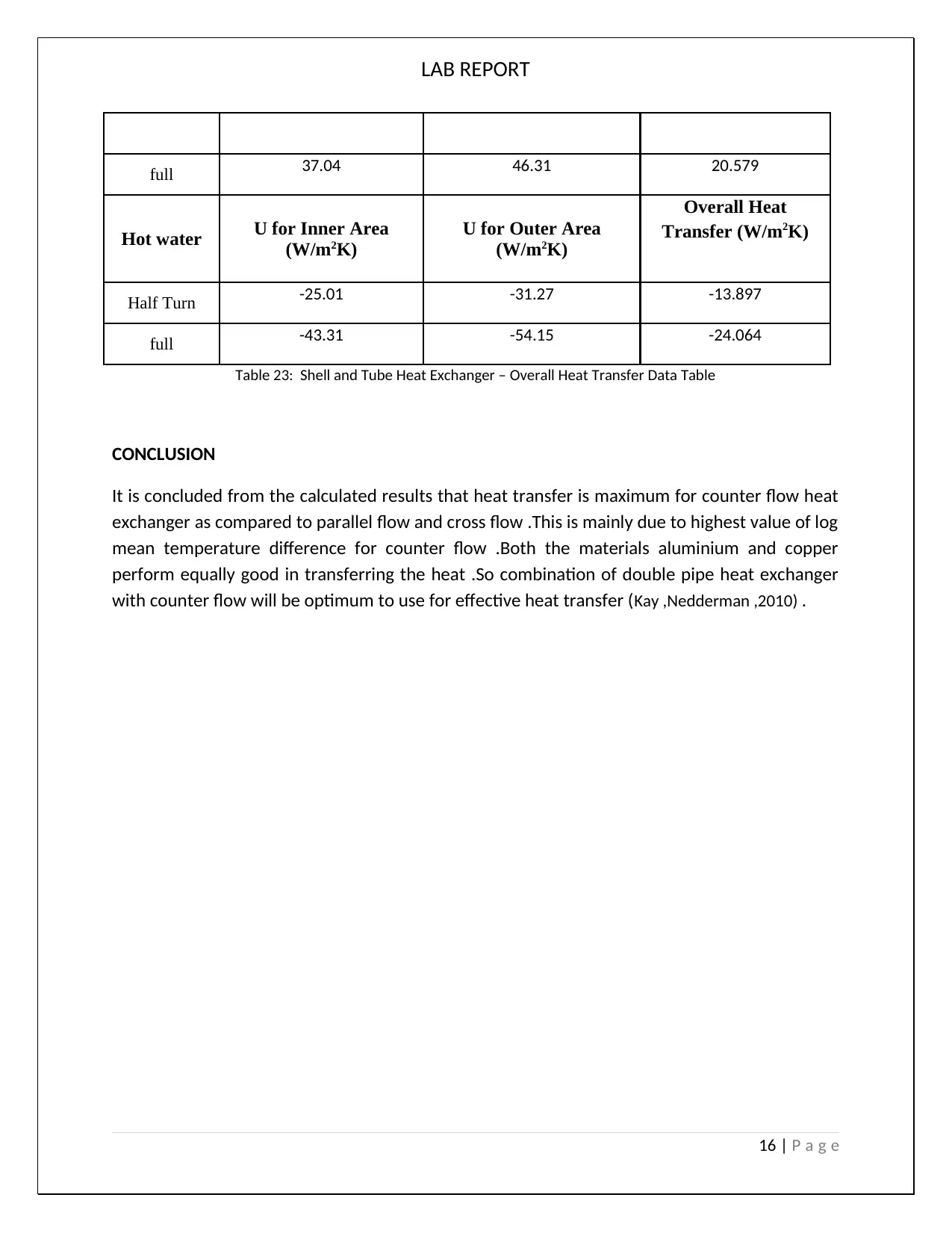
LAB REPORT
full 37.04 46.31 20.579
Hot water U for Inner Area
(W/m2K)
U for Outer Area
(W/m2K)
Overall Heat
Transfer (W/m2K)
Half Turn -25.01 -31.27 -13.897
full -43.31 -54.15 -24.064
Table 23: Shell and Tube Heat Exchanger – Overall Heat Transfer Data Table
CONCLUSION
It is concluded from the calculated results that heat transfer is maximum for counter flow heat
exchanger as compared to parallel flow and cross flow .This is mainly due to highest value of log
mean temperature difference for counter flow .Both the materials aluminium and copper
perform equally good in transferring the heat .So combination of double pipe heat exchanger
with counter flow will be optimum to use for effective heat transfer (Kay ,Nedderman ,2010) .
16 | P a g e
full 37.04 46.31 20.579
Hot water U for Inner Area
(W/m2K)
U for Outer Area
(W/m2K)
Overall Heat
Transfer (W/m2K)
Half Turn -25.01 -31.27 -13.897
full -43.31 -54.15 -24.064
Table 23: Shell and Tube Heat Exchanger – Overall Heat Transfer Data Table
CONCLUSION
It is concluded from the calculated results that heat transfer is maximum for counter flow heat
exchanger as compared to parallel flow and cross flow .This is mainly due to highest value of log
mean temperature difference for counter flow .Both the materials aluminium and copper
perform equally good in transferring the heat .So combination of double pipe heat exchanger
with counter flow will be optimum to use for effective heat transfer (Kay ,Nedderman ,2010) .
16 | P a g e
Secure Best Marks with AI Grader
Need help grading? Try our AI Grader for instant feedback on your assignments.
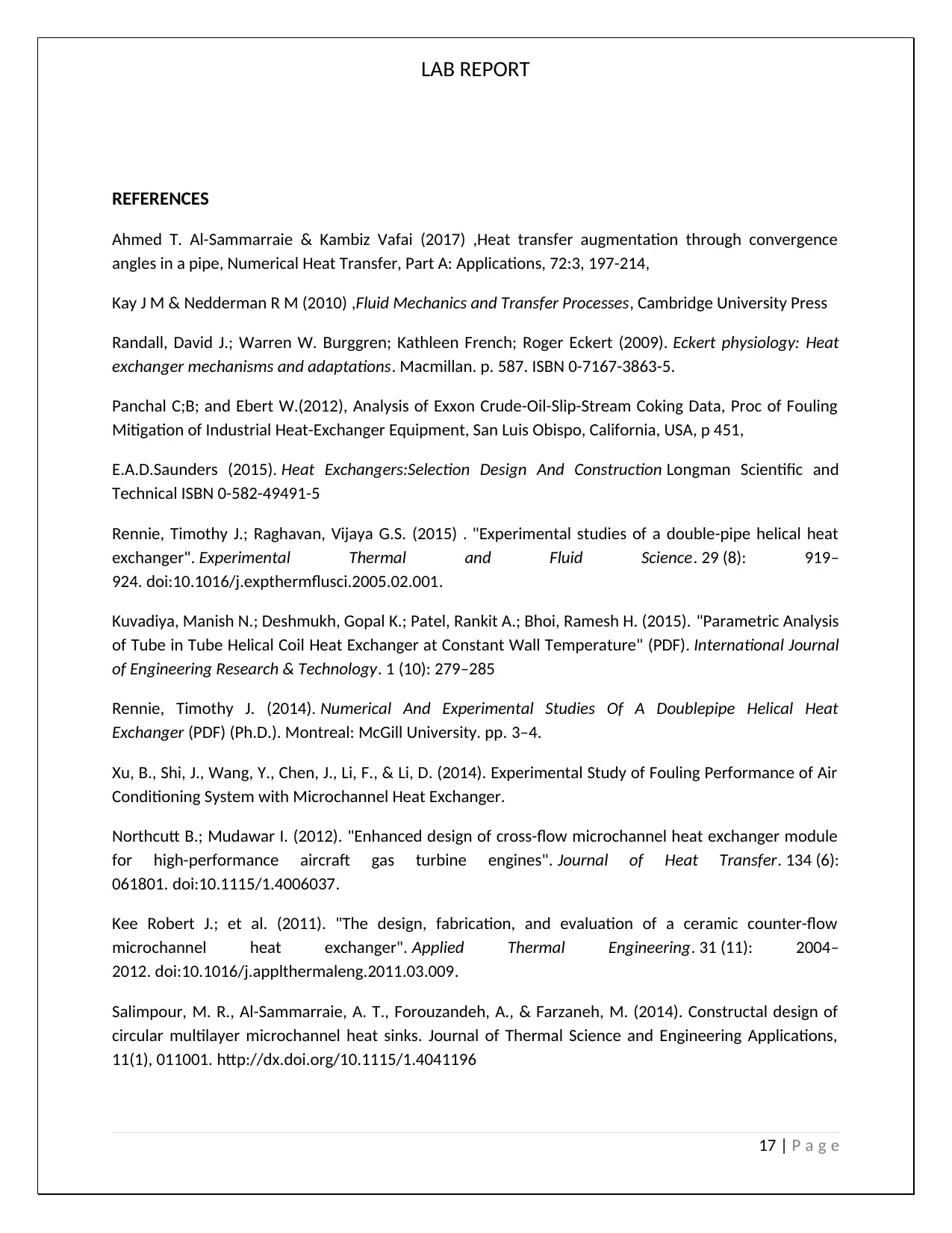
LAB REPORT
REFERENCES
Ahmed T. Al-Sammarraie & Kambiz Vafai (2017) ,Heat transfer augmentation through convergence
angles in a pipe, Numerical Heat Transfer, Part A: Applications, 72:3, 197-214,
Kay J M & Nedderman R M (2010) ,Fluid Mechanics and Transfer Processes, Cambridge University Press
Randall, David J.; Warren W. Burggren; Kathleen French; Roger Eckert (2009). Eckert physiology: Heat
exchanger mechanisms and adaptations. Macmillan. p. 587. ISBN 0-7167-3863-5.
Panchal C;B; and Ebert W.(2012), Analysis of Exxon Crude-Oil-Slip-Stream Coking Data, Proc of Fouling
Mitigation of Industrial Heat-Exchanger Equipment, San Luis Obispo, California, USA, p 451,
E.A.D.Saunders (2015). Heat Exchangers:Selection Design And Construction Longman Scientific and
Technical ISBN 0-582-49491-5
Rennie, Timothy J.; Raghavan, Vijaya G.S. (2015) . "Experimental studies of a double-pipe helical heat
exchanger". Experimental Thermal and Fluid Science. 29 (8): 919–
924. doi:10.1016/j.expthermflusci.2005.02.001.
Kuvadiya, Manish N.; Deshmukh, Gopal K.; Patel, Rankit A.; Bhoi, Ramesh H. (2015). "Parametric Analysis
of Tube in Tube Helical Coil Heat Exchanger at Constant Wall Temperature" (PDF). International Journal
of Engineering Research & Technology. 1 (10): 279–285
Rennie, Timothy J. (2014). Numerical And Experimental Studies Of A Doublepipe Helical Heat
Exchanger (PDF) (Ph.D.). Montreal: McGill University. pp. 3–4.
Xu, B., Shi, J., Wang, Y., Chen, J., Li, F., & Li, D. (2014). Experimental Study of Fouling Performance of Air
Conditioning System with Microchannel Heat Exchanger.
Northcutt B.; Mudawar I. (2012). "Enhanced design of cross-flow microchannel heat exchanger module
for high-performance aircraft gas turbine engines". Journal of Heat Transfer. 134 (6):
061801. doi:10.1115/1.4006037.
Kee Robert J.; et al. (2011). "The design, fabrication, and evaluation of a ceramic counter-flow
microchannel heat exchanger". Applied Thermal Engineering. 31 (11): 2004–
2012. doi:10.1016/j.applthermaleng.2011.03.009.
Salimpour, M. R., Al-Sammarraie, A. T., Forouzandeh, A., & Farzaneh, M. (2014). Constructal design of
circular multilayer microchannel heat sinks. Journal of Thermal Science and Engineering Applications,
11(1), 011001. http://dx.doi.org/10.1115/1.4041196
17 | P a g e
REFERENCES
Ahmed T. Al-Sammarraie & Kambiz Vafai (2017) ,Heat transfer augmentation through convergence
angles in a pipe, Numerical Heat Transfer, Part A: Applications, 72:3, 197-214,
Kay J M & Nedderman R M (2010) ,Fluid Mechanics and Transfer Processes, Cambridge University Press
Randall, David J.; Warren W. Burggren; Kathleen French; Roger Eckert (2009). Eckert physiology: Heat
exchanger mechanisms and adaptations. Macmillan. p. 587. ISBN 0-7167-3863-5.
Panchal C;B; and Ebert W.(2012), Analysis of Exxon Crude-Oil-Slip-Stream Coking Data, Proc of Fouling
Mitigation of Industrial Heat-Exchanger Equipment, San Luis Obispo, California, USA, p 451,
E.A.D.Saunders (2015). Heat Exchangers:Selection Design And Construction Longman Scientific and
Technical ISBN 0-582-49491-5
Rennie, Timothy J.; Raghavan, Vijaya G.S. (2015) . "Experimental studies of a double-pipe helical heat
exchanger". Experimental Thermal and Fluid Science. 29 (8): 919–
924. doi:10.1016/j.expthermflusci.2005.02.001.
Kuvadiya, Manish N.; Deshmukh, Gopal K.; Patel, Rankit A.; Bhoi, Ramesh H. (2015). "Parametric Analysis
of Tube in Tube Helical Coil Heat Exchanger at Constant Wall Temperature" (PDF). International Journal
of Engineering Research & Technology. 1 (10): 279–285
Rennie, Timothy J. (2014). Numerical And Experimental Studies Of A Doublepipe Helical Heat
Exchanger (PDF) (Ph.D.). Montreal: McGill University. pp. 3–4.
Xu, B., Shi, J., Wang, Y., Chen, J., Li, F., & Li, D. (2014). Experimental Study of Fouling Performance of Air
Conditioning System with Microchannel Heat Exchanger.
Northcutt B.; Mudawar I. (2012). "Enhanced design of cross-flow microchannel heat exchanger module
for high-performance aircraft gas turbine engines". Journal of Heat Transfer. 134 (6):
061801. doi:10.1115/1.4006037.
Kee Robert J.; et al. (2011). "The design, fabrication, and evaluation of a ceramic counter-flow
microchannel heat exchanger". Applied Thermal Engineering. 31 (11): 2004–
2012. doi:10.1016/j.applthermaleng.2011.03.009.
Salimpour, M. R., Al-Sammarraie, A. T., Forouzandeh, A., & Farzaneh, M. (2014). Constructal design of
circular multilayer microchannel heat sinks. Journal of Thermal Science and Engineering Applications,
11(1), 011001. http://dx.doi.org/10.1115/1.4041196
17 | P a g e
1 out of 17
Related Documents
Your All-in-One AI-Powered Toolkit for Academic Success.
+13062052269
info@desklib.com
Available 24*7 on WhatsApp / Email
![[object Object]](/_next/static/media/star-bottom.7253800d.svg)
Unlock your academic potential
© 2024 | Zucol Services PVT LTD | All rights reserved.





